A Place for Fearless Progress

An intention to change whatever stands in the way of justice. A passion to find new ways to empower everyone.
It is not just intellect that drives innovation, but unwavering heart.

THE HEART REQUIRED TO TAKE ON THE BIGGEST CHALLENGES OF THESE TIMES. The courage to persist, knowing that this work is never finished.
It is not just the desire to change the world that matters; it is the fearlessness it takes to get there.
2 THE NEW SCHOOL
It is not bravado that moves the world forward, but intent.
FEARLESSNESS IN THOUGHT. IN CREATIVITY.

And in encouraging a new generation of scholars to explore the impossible.
This is what it means to be a university that calls itself
THE NEW SCHOOL.
TO BE A PLACE FOR FEARLESS PROGRESS.
3 A place for fearless progress
Since its founding in 1919, The New School has been a renowned center of independent thought and courageous action, a community applying bold, forward-looking approaches to global problems and leading the systemic change needed to make the world more just, sustainable, and beautiful.
Today our university is made up of seven colleges offering programs in art and design, liberal arts and social sciences, music and performance, management, media, and more. Our community in New York and around the world is dedicated to using the power of creativity to lead the way to a better future for all.
Parsons School of Design

Eugene Lang College of Liberal Arts College of Performing Arts
The New School for Social Research
Schools
of Public Engagement
Parsons Paris Continuing and Professional Education
4 THE NEW SCHOOL
10,000+ students enrolled at The New School (71% undergraduate, 29% graduate)
#1 art and design school in the United States, Parsons School of Design1
1Ranking for Parsons School of Design, Quacquarelli Symonds World University Rankings, 2021.
126 undergraduate and graduate degree and diploma programs offered
#1 most international university2
2U.S. News & World Report, 2020. Based on the percentage of international students at U.S. universities with more than 10,000 students.
A Few Facts About Us
10:1 student-to-faculty ratio

30 consecutive years of Fulbrights awarded to our community members
43 alumni in Forbes’ 30 Under 30 since the list’s inception in 2011
3,300+ adult, youth, and pre-college students in continuing and professional education programs
5 A place for fearless progress
Addressing the world’s greatest challenges requires a fearless approach to research. We research to create.

To design. To instigate change.
How do we do research? We bring together disparate groups to solve a problem. The combination of expertise and perspectives creates something flexible, innovative, and unexpected. The myth of the lone individual developing the big idea that can solve big problems is just that—a myth. Rather than an endgame,

6 THE NEW SCHOOL
research is the first step in harnessing the collective knowledge of The New School.

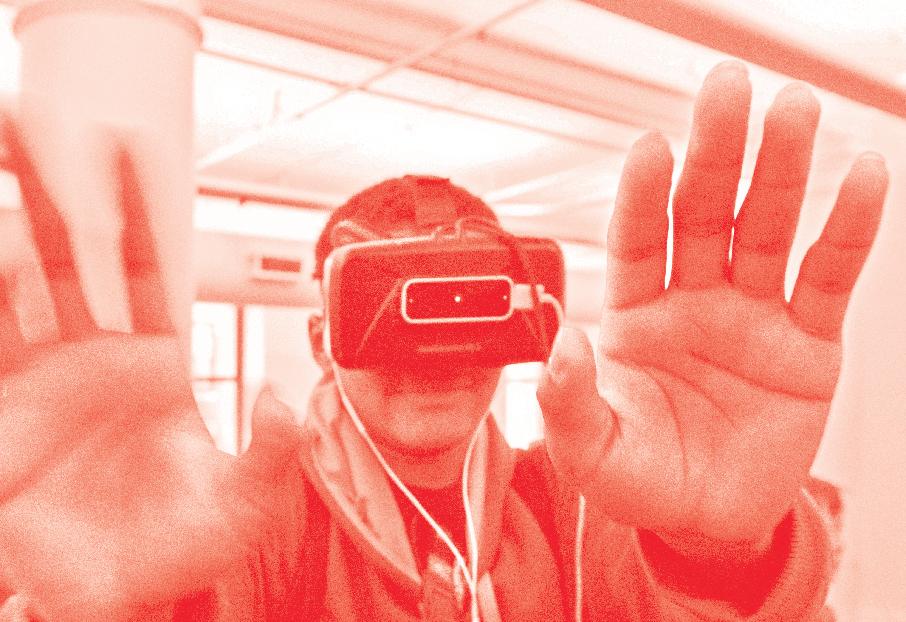
7 A place for fearless progress
“Research looks very different here,” says Adam Brown, an associate professor of clinical psychology and vice provost for Research. “Because we house the #1 design school in the United States, where technology is infused into so much of what’s happening, we have the opportunity to access these cuttingedge ways of addressing issues. It’s a unique sort of hybrid, this interesting species of design plus performing arts combined with social sciences and humanities, that creates a unique organism, an intellectual organism that allows our students to work really differently.”
Because of our openness to stepping outside of disciplinary boundaries, to departing from rigid hierarchy, there is a freedom of expression and experimentation that is unique to The New School. The result may take the form of a book or journal article, but also that of a photograph or dance or music. It is about engagement.
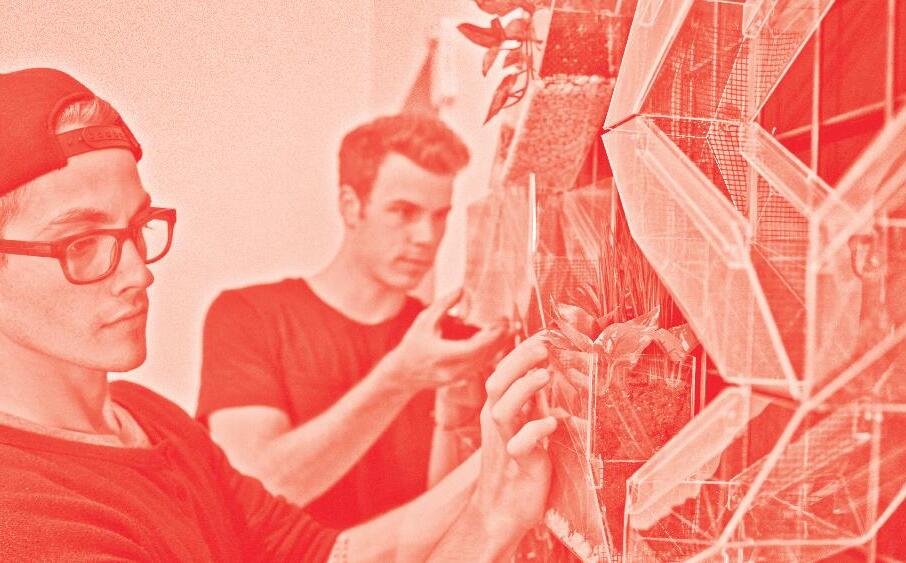

8 THE NEW SCHOOL
“While we are very much an academic institution, we are so engaged with our communities, with the
places in which we live, that our approach is not solely academic, but rather always about impact. How are we affecting our communities? How are we facilitating real change for the better?” says Brown, citing some of the critical questions that The New School asks of its students.
Voting rights, housing access, the economy, mental health, social justice, the arts, the criminal justice system—The New School has permanently changed the way the world thinks about these topics, and that impact flows directly into the communities where we live. Our ideas are not confined within our studios and classrooms; they manifest themselves in the communities where we do our work.

9 A place for fearless progress
The New School’s scholars have a long history of approaching topics in completely new ways. Our Psychology department recently received a grant of $3.5 million from the National Institutes of Health that is funding a groundbreaking project in coordination with the NYC Mayor’s Office and community-based organizations. The program trains people who are not mental health experts in mental health interventions that they can deliver within their own communities. This effort will serve as a model for cities around the country that are dealing with lack of access to mental health resources. This is a project that can shape the rebuilding of New York and our nation—just one of the many The New School is being invited to lead.
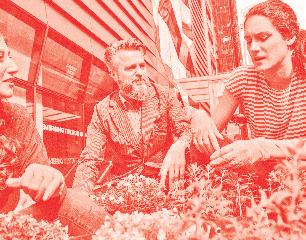
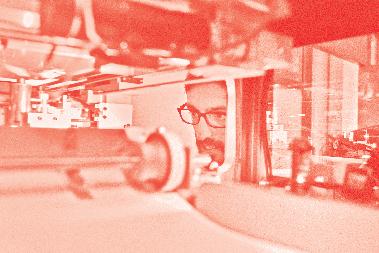



10 THE NEW SCHOOL
40+ CENTERS, INSTITUTES, AND LABS FOR RESEARCH AND APPLIED WORK
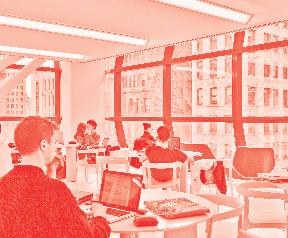
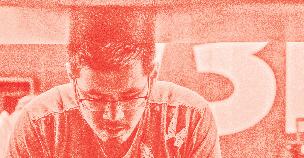
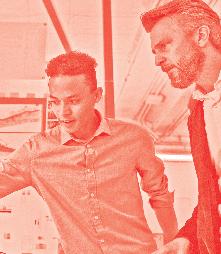
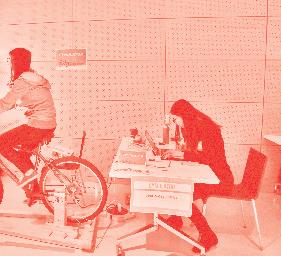

A place for fearless progress

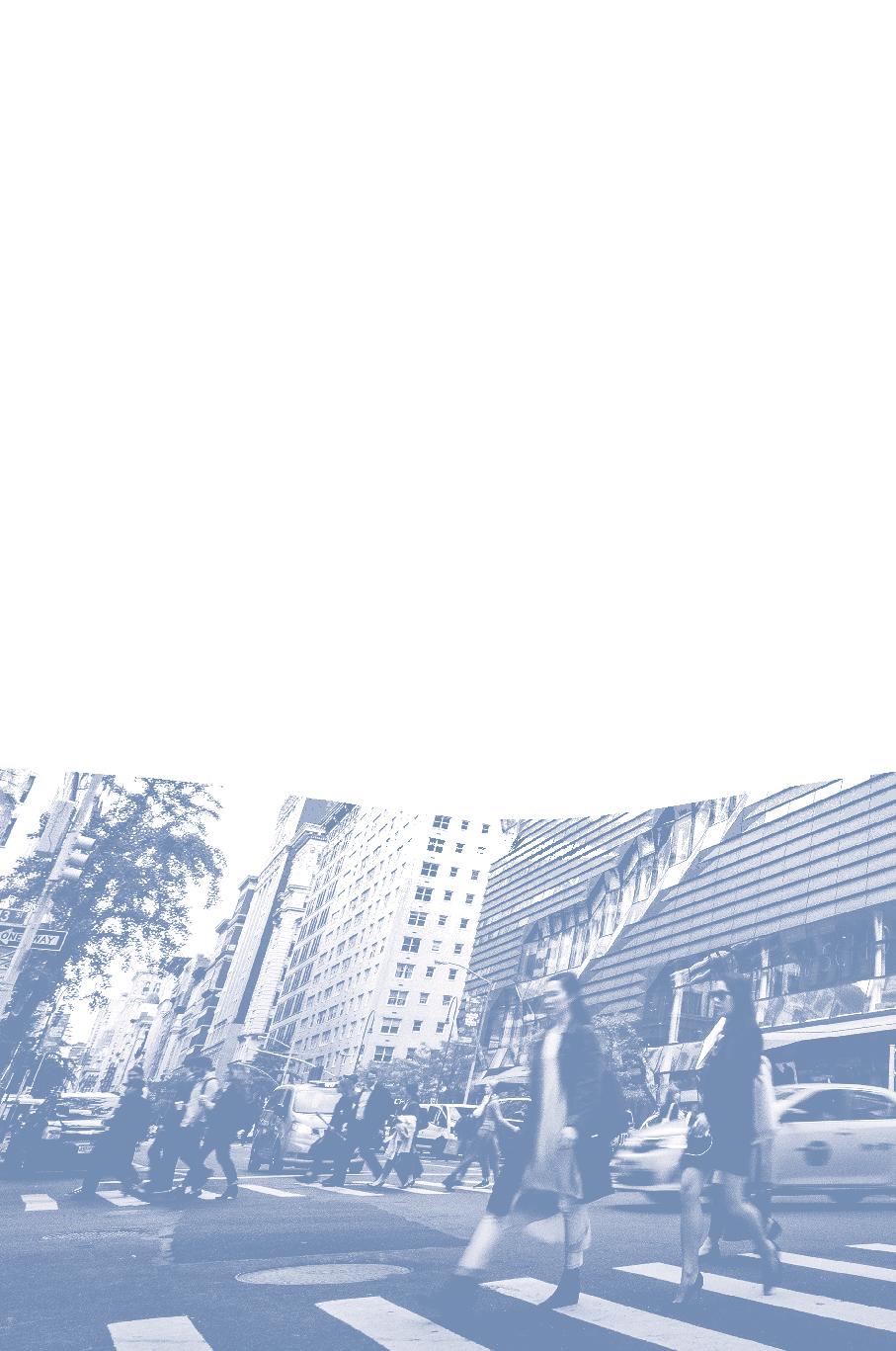

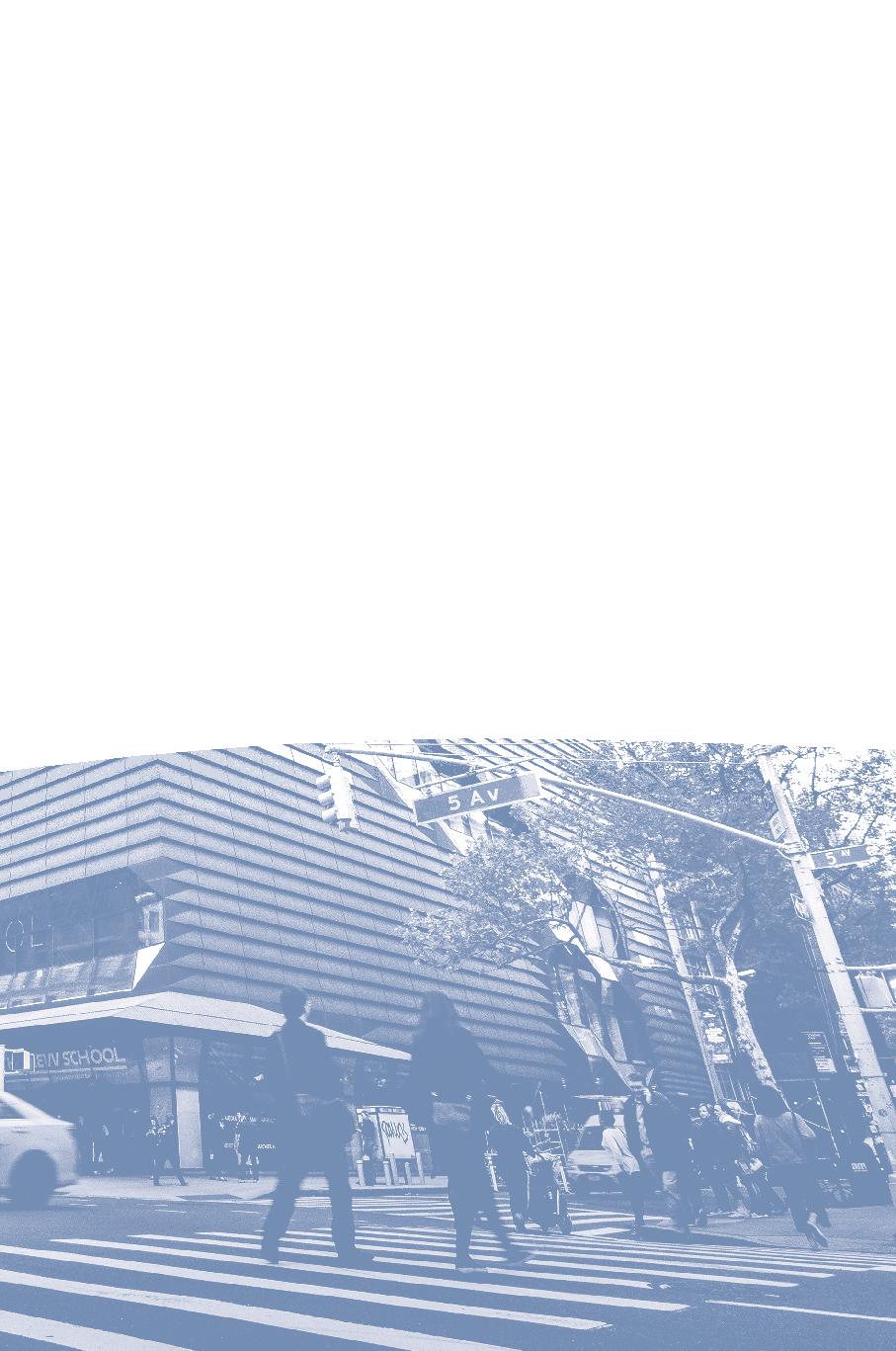
“For education among all kinds of men always has had, and always will have, an element of danger and revolution, of dissatisfaction and discontent.”
W.E.B. DuBois, teacher of The New School’s first course on African American history, in 1948
SEVEN STORIES ABOUT THE NEW SCHOOL
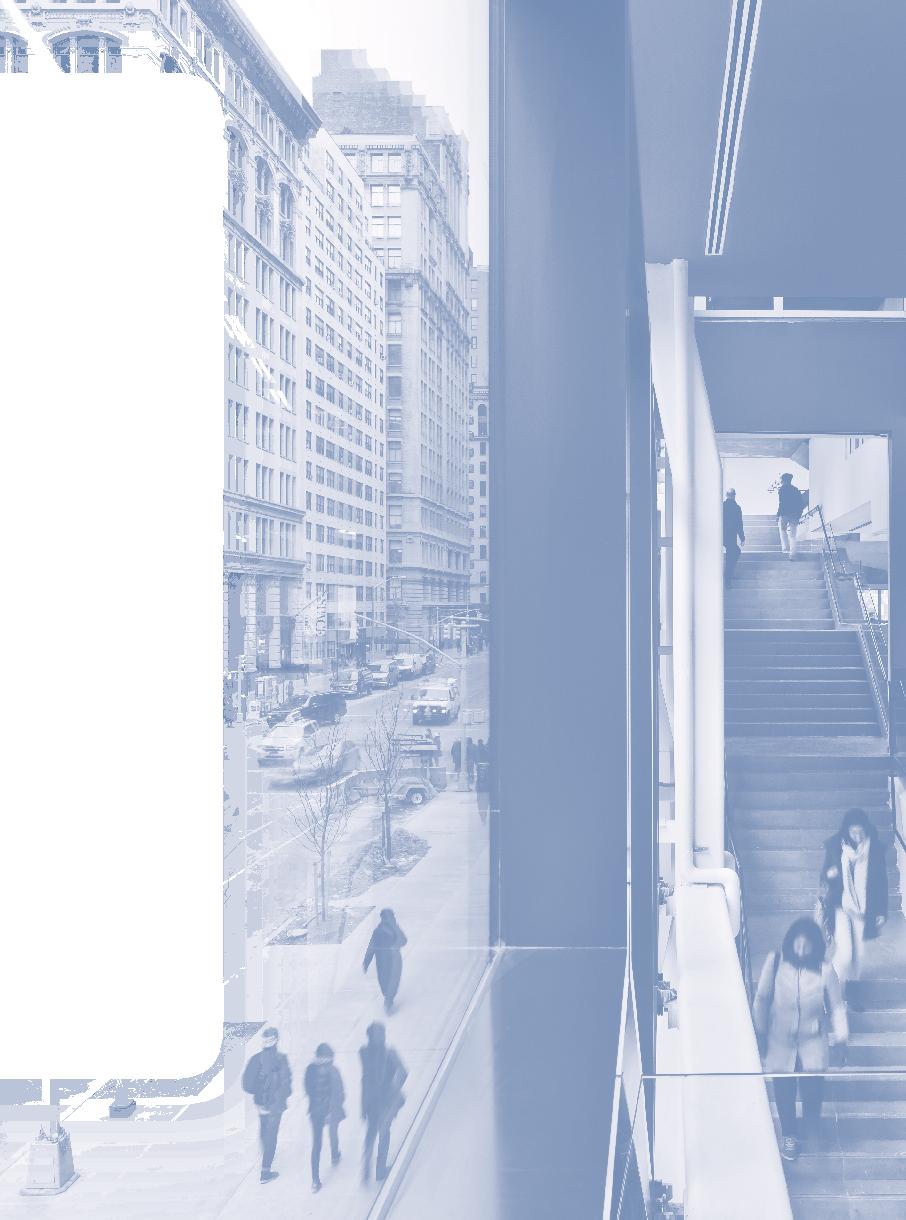


14 THE NEW SCHOOL
Creating a Moral Economy


Poverty is a political choice of a society, a matter of political will. The need to make this concept understandable to all is one of the many reasons the Institute on Race, Power and Political Economy was established at The New School in 2020. Its goal is to develop initiatives promoting economic rights with the awareness that political and civil rights are simply not complete without them. The Institute’s founder, University Professor Darrick Hamilton, states:
“If we really want to forge selfdetermination, if we really want to forge authentic agency for people, then we have to recognize that without some baseline level of a job, income, health insurance, food, and shelter, people simply don’t have agency.”
The Institute recognizes that the inequalities that have developed over centuries cannot be undone through small ideas. Structural problems require transformational ideas grounded in rigorous research. And that is what The New School and the Institute on Race, Power and Political Economy have set out to provide—not just in communities but in the minds of students at the university.
15
The Institute’s work is rooted in a stark assessment of our world: To Black people and other people of color, to women, to immigrants, to Indigenous peoples, and to many others with identities different from those of socially dominant groups, society offers less wealth, more discrimination, more violence, poorer healthcare, fewer protections, and less economic, cultural, and political power.

16 THE NEW SCHOOL
“So while the basis of the Institute is intellectual, we use phenomena and data to try to understand relationships. We are interested in knowledge creation not solely for the sake of knowledge creation but rather to move closer to the values we hope to achieve. We aim to use knowledge as a means to promote a moral economy, to
promote agency among people, to promote self-determination, economic inclusion, civic engagement, and social equity across not just class identity but all social identities like race, gender, and sexual orientation.
“People have rarely understood the role the public and politics have in choosing the type of society we desire. Economic growth as a measure of how well an economy is doing is very much a political choice. We can choose to value other things and invest in other things like human dignity and human capability. It is our choice as a society. Helping people understand this is a critical part of the work we do,” says Hamilton.

Creating a Moral Economy 17
The Institute draws on faculty and students across The New School, which has long fostered groundbreaking thinking about power, structure, design, politics, economics, and society. The Institute engages researchers and practitioners, including community and business leaders, policymakers,
philanthropists, and journalists, across the nation and around the world.
Getting people to understand the realities of economic justice will not be easy, but the Institute puts the complex into language designed to bend our politics toward attaining justice. Says Hamilton,

their

18 THE NEW SCHOOL
“Wealth inequality can be distilled into this: Some people have access to capital at a key point in their lives that allows them to get into assets that will passively increase over
lifetimes. We’re not talking about their effort; we’re talking about the difference between a renter and an owner being a down payment. The difference between an entrepreneur and a worker is capital to float that idea into something that is marketized. And baby bonds are pretty simple. It is our government ensuring a birthright to capital for everyone.”

Creating a Moral Economy 19
Average Hourly Wages by Race/Ethnicity and Education1 $45 $30 $15 $0 NO HIGH SCHOOL DEGREE HIGH SCHOOL SOME COLLEGE COLLEGE DEGREE ADVANCED DEGREE $13.77 $14.11 $11.42 White Latinx Black $19.75 $17.28 $15.57 $21.58 $18.66 $17.15 $34.75 $28.49 $27.46 $44.46 $38.47 $36.23 12018.
These are the kinds of initiatives we need to create a moral economy. These are the initiatives the Institute is fearlessly pushing forward for all.


20 THE NEW SCHOOL
Building a Healthier Planet
Perhaps the simplest way to bring to life what the Healthy Materials Lab (HML) does is to tell you about a new building material—a material made of hemp, lime, and water, radical in that it is made of plants and minerals, containing none of the thousands of petrochemicals found in modern building materials. The material is nontoxic and is designed to be used in the construction of affordable housing, not at the higher end of the market, where most sustainability advances are made.
HML was founded on the

belief that providing safe homes for all is the way to achieve true equity in the world. The lab began its HempLime journey exploring block production, and today HML, working in partnership with DON Enterprises, an organization that builds housing for people with disabilities, and Americhanvre, a contractor specializing in HempLime construction, is building a house in Pennsylvania using HempLime walls—proof that safe affordable housing can and does exist and can ultimately be scaled up to become the dominant model.

21
Alison Mears, HML director and co-founder, says, “The intention of our Healthy Materials Lab is to use advancements like this to transform the life of one person, one family, two families, a million families, and beyond.”

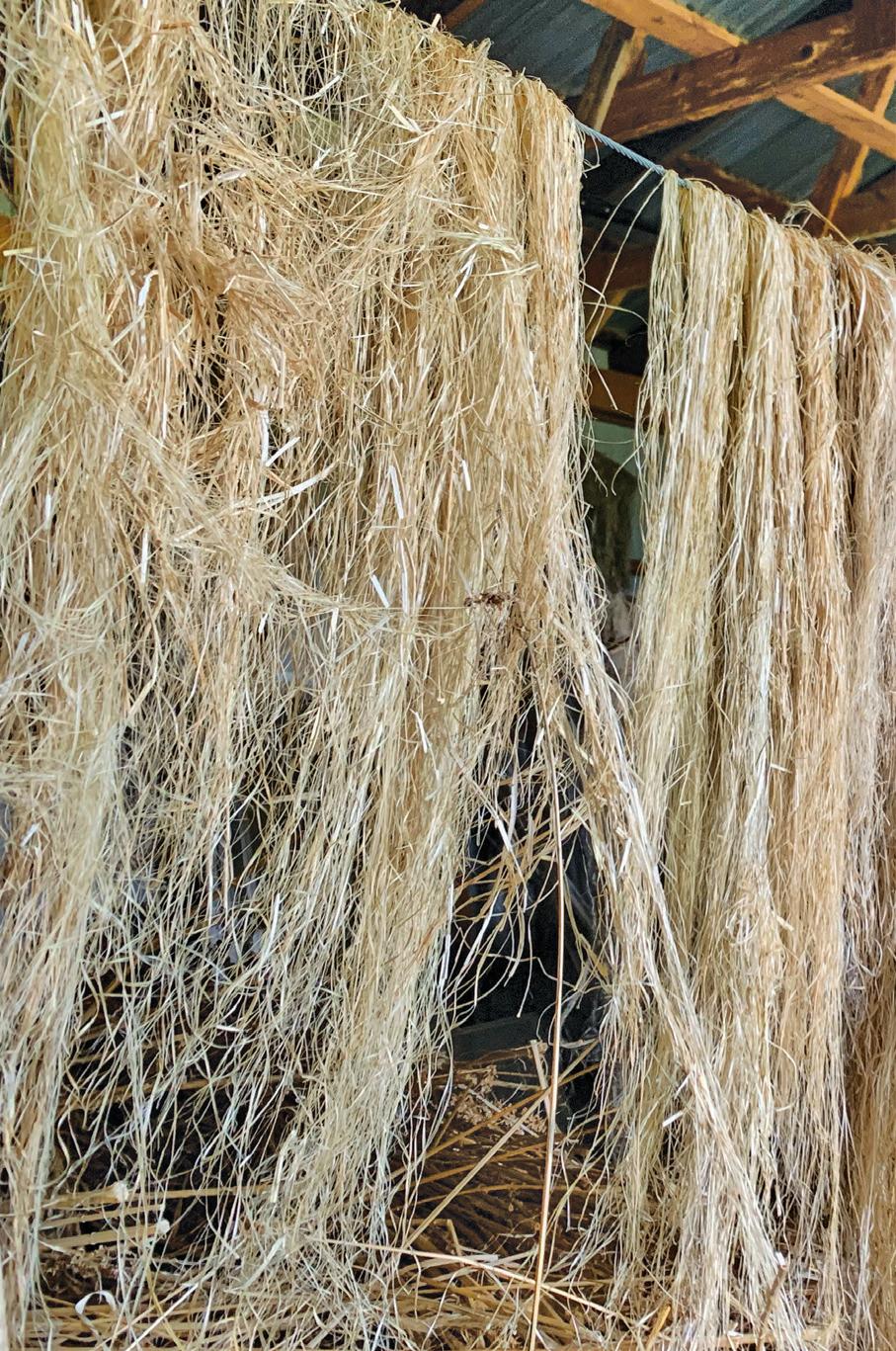
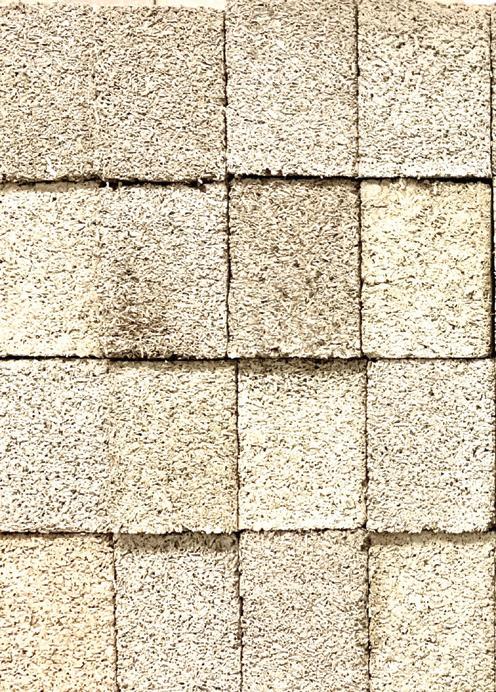
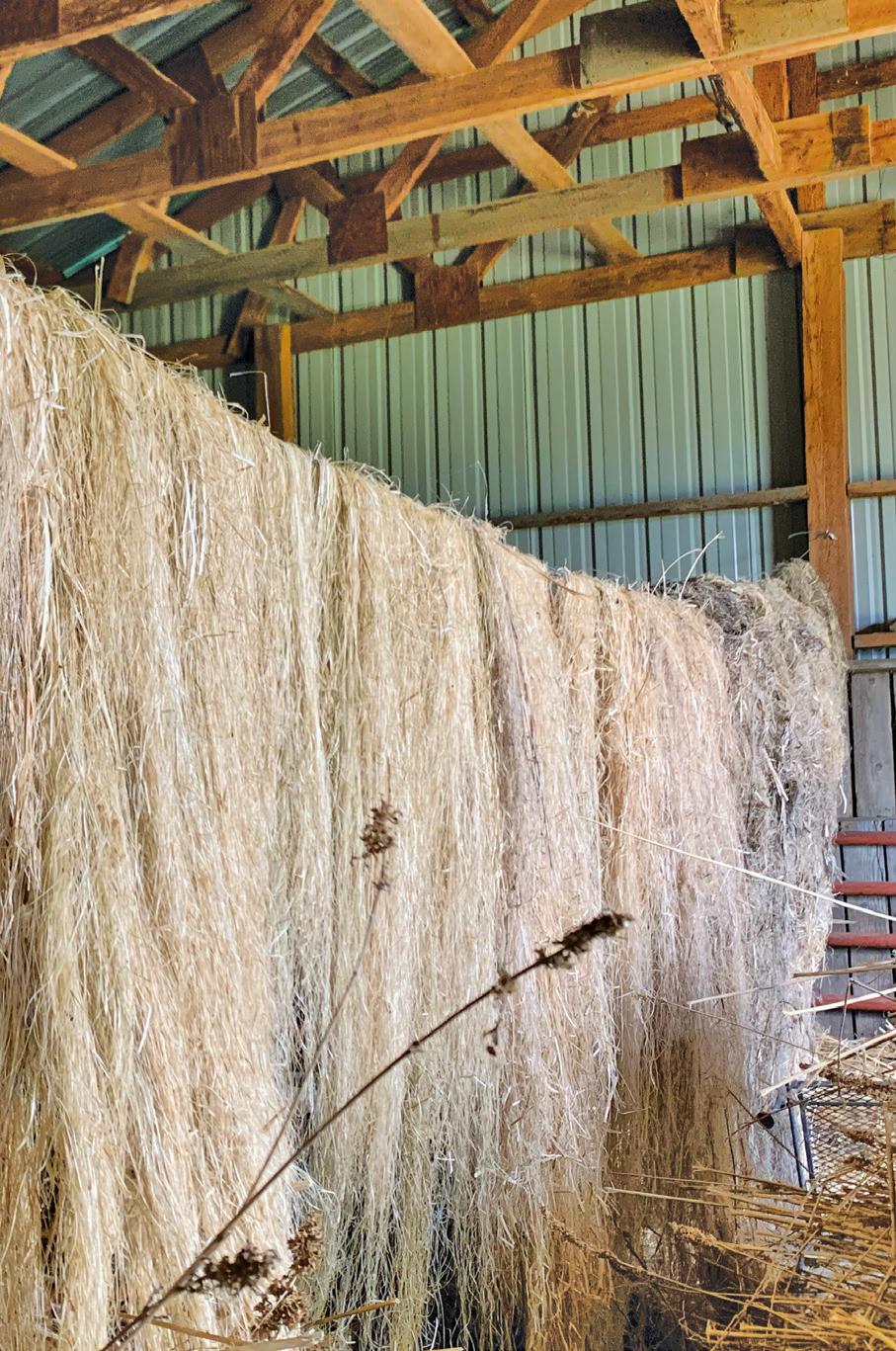
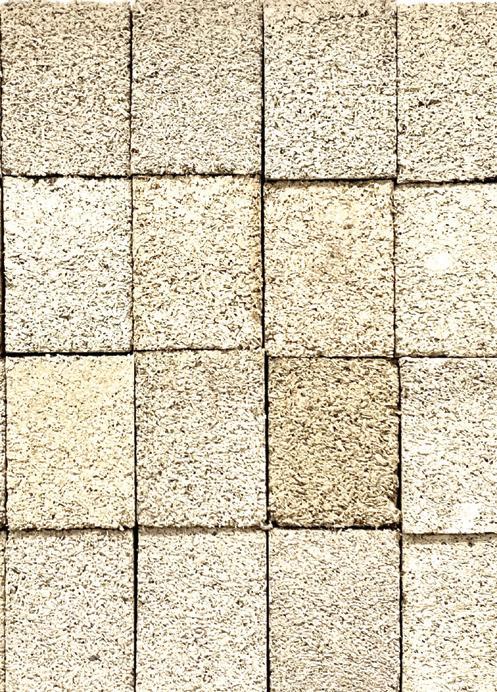
The lab is dedicated to creating a world in which people’s health is placed at the center of all design decisions. It is composed of faculty and students working in the context of the university.
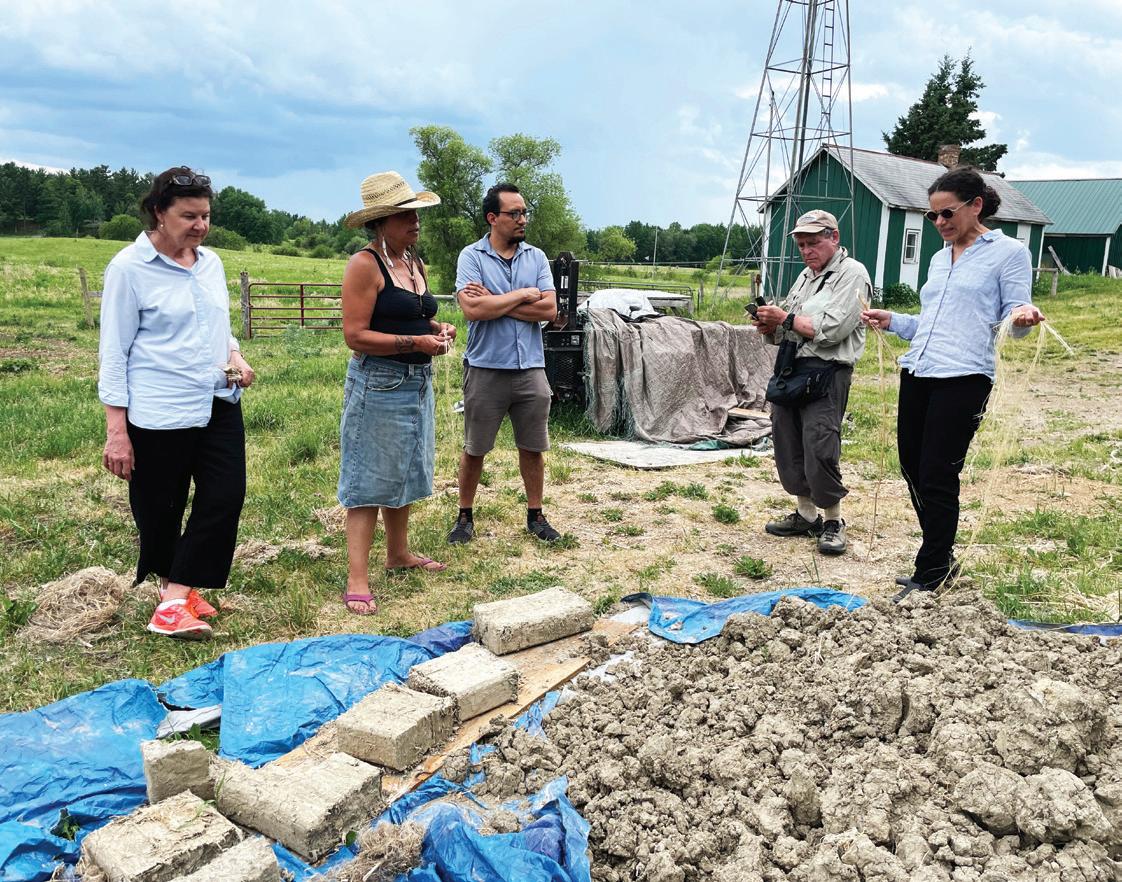
“First and foremost, we are practitioners—designers and architects who want to make real change. We don’t necessarily want to publish research papers. We are not interested in the theory of something. We want to do that kind of investigation and then test and implement it in real time in a real place.”

24 THE NEW SCHOOL
Design director and HML co-founder
Jonsara Ruth says, “We see design as an imaginative and performative tool to make change, but we’re also a lab in the way that we experiment, we explore, we investigate new paradigms.”
“We take the risks; we don’t expect other people to take the risks. Because we work within the context of The New School, we’re able to fail sometimes. But when there are successes, the goal is to share that knowledge with others, so that they can make exponential change in their practice,” says Mears.

Building a Healthier Planet 25
The New School believes partnerships and collabs are the way forward—that only by working with toxicologists and other scientists, statisticians and people in the public health arena, can we transform the way people see and understand an issue.
The lab often works with other organizations to amplify the change they are working to achieve. For example, HML is currently partnering with Kia Weatherspoon and her company, Determined by Design, a design firm committed to the concept of design equity—the notion that everyone, regardless of wealth, deserves high-quality design. HML is working with Weatherspoon’s team to help them choose safer materials in the design of affordable housing.
“We are also working with Winona LaDuke on the White Earth Reservation. The rates of homelessness on reservations are staggering, and support for housing is seriously underfunded. We’re taking the knowledge that HML has acquired through other projects to transfer it to their local building groups to help them prototype housing that will become the new model of healthier housing on the reservation,” says Mears.

26 THE NEW SCHOOL
“The lab has built a robust educational platform from which to teach professionals as well as our students, the next generation of architects and designers, about more healthful building practices. We’re also constantly vetting new materials to see what their toxicity is. We believe this is the way the building industry will move from an old practice to a new practice,” says Ruth.

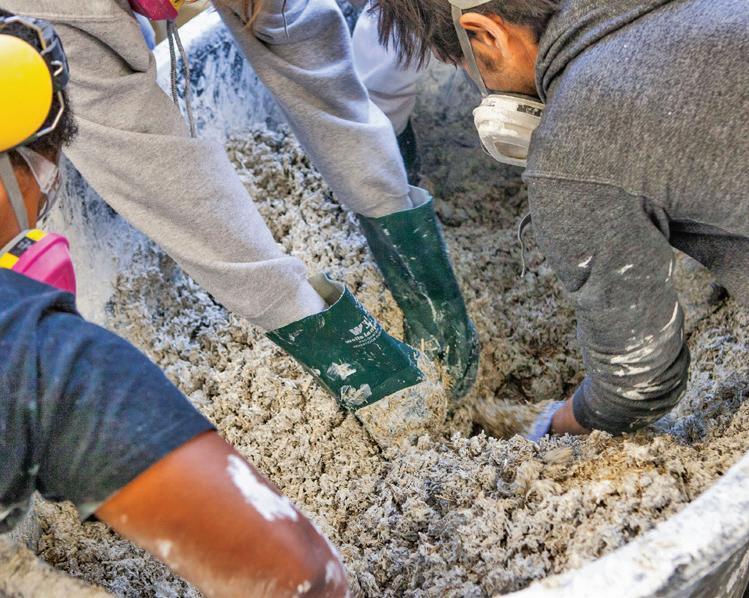
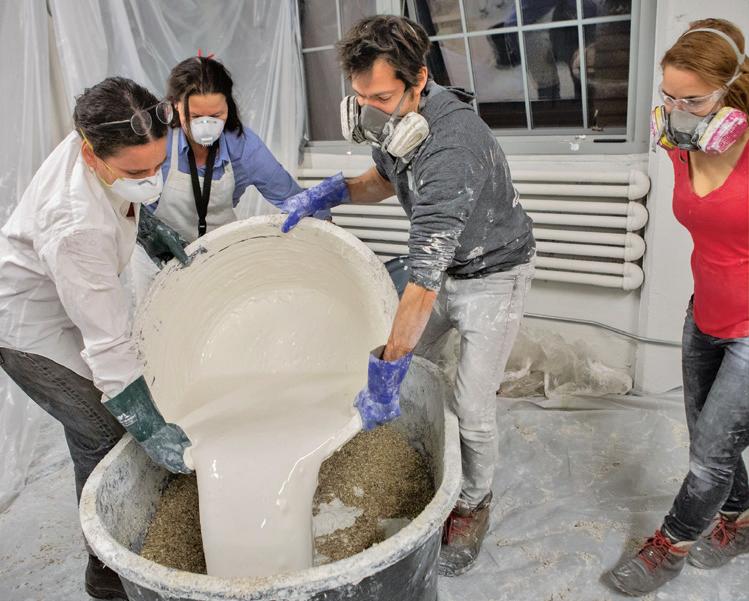
Building a Healthier Planet 27

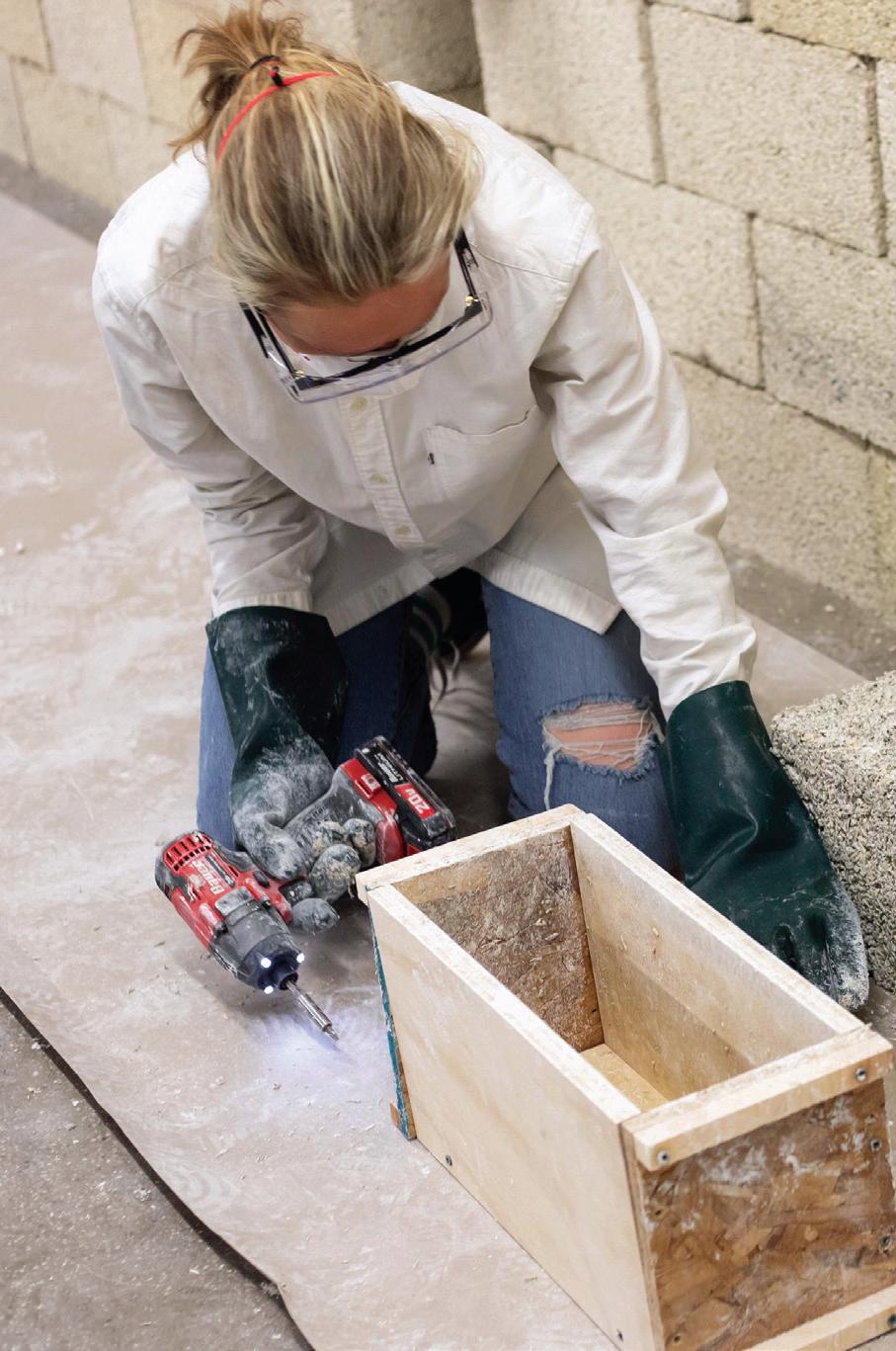
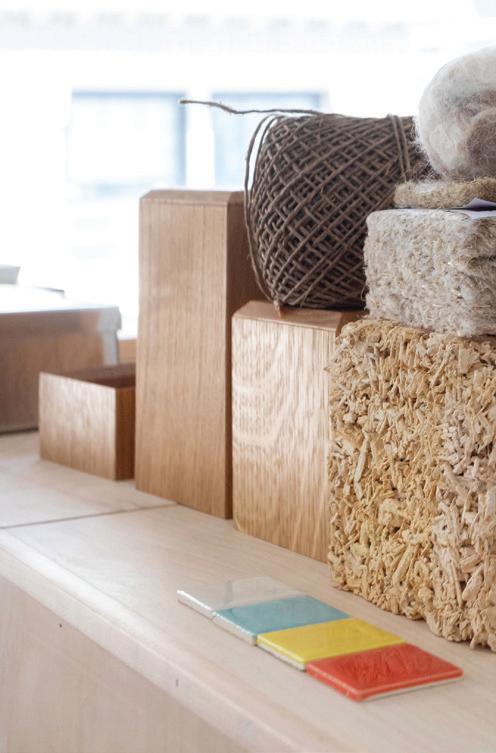

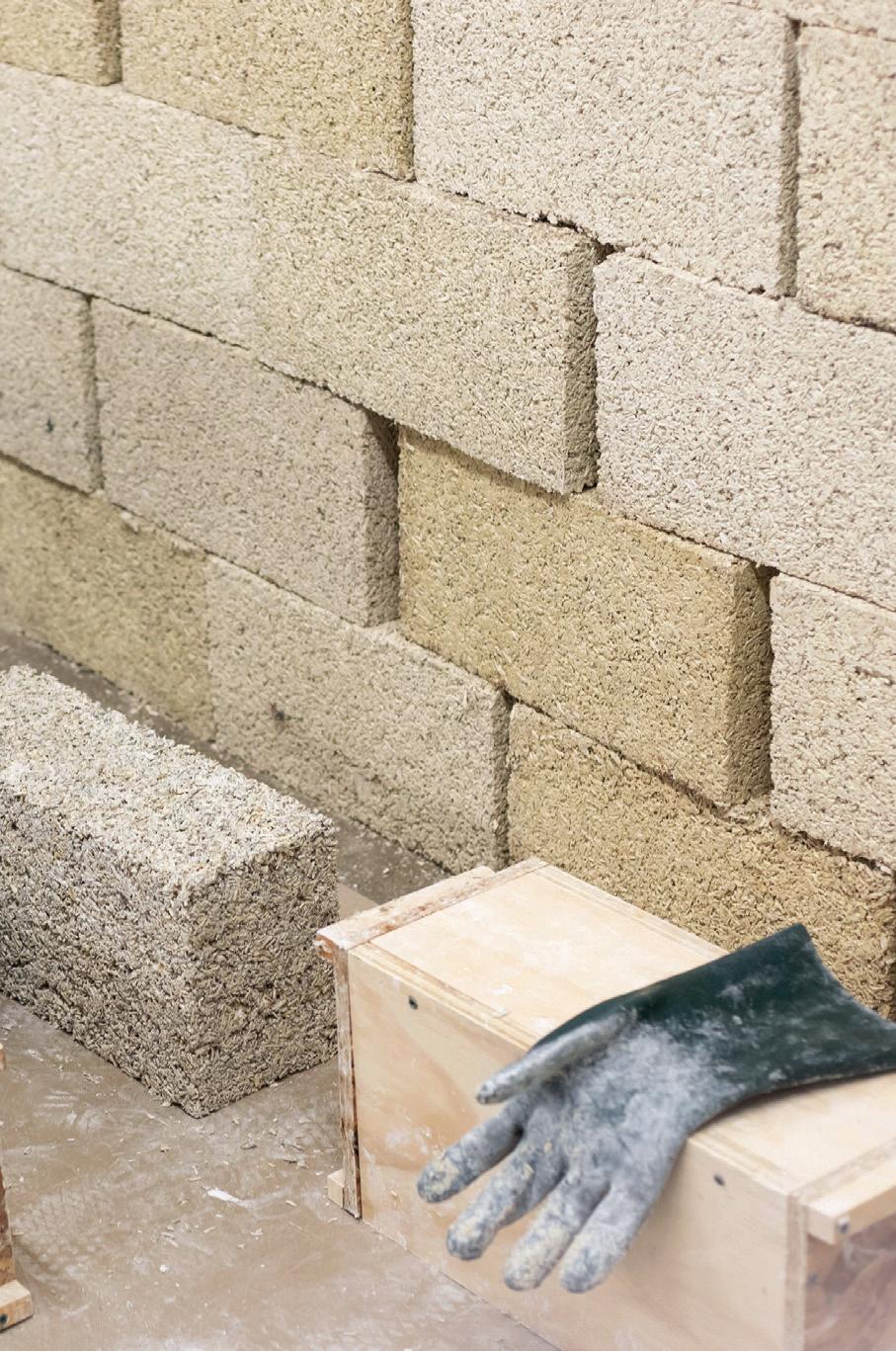
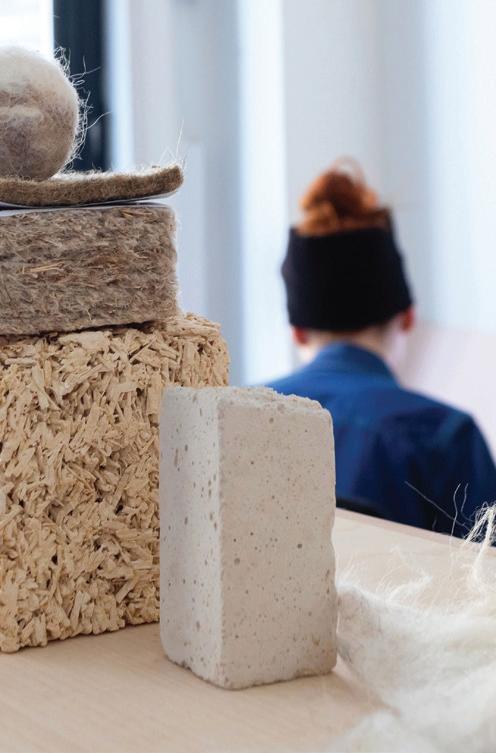
Block
by block, the Healthy
Materials
Lab is moving students, architects, builders, and the entire industry forward, fearlessly making an impact on human health, environmental justice, and social equity across the country and the world.

30 30 THE NEW SCHOOL
A Critical Moment to Reclaim Data

Technology has never been more essential to our daily rituals. Yet whenever we log on, we are bound to the language embedded in the fine print. In order to use digital platforms, we agree to cede bits of information that when collected and collated tell a detailed story of who we are.
Like all of those who have interacted with digital technology, David Carroll has had his personal data collected. Carroll is an associate professor of media design at Parsons, where he specializes in interface design, mobile media, programming, social media, and transdisciplinary design. He is well versed in the mechanisms of data collection, the way
technology is programmed to gobble data up each time people browse, scroll, like, and share on apps and websites.
In 2017, Carroll began to focus on Cambridge Analytica, a British data analytics firm that touted its ability to target political advertising to individuals on the basis of data collected— without consent—from millions of Facebook profiles.
31
Once collected, this data is no longer ours. It can be used by anyone for any purpose they deem suitable. It can even be used to manipulate us.
Carroll decided to take Cambridge Analytica to court to retrieve his personal data—a dossier of information on everything from personal investments to personality traits—and find the answers to these questions: Where did the company get his data, what did it do with the data, and with whom did it share the data?
“I wanted to pry open the secret world of voter targeting,” Carroll says, noting that Cambridge Analytica played a starring role in Donald Trump’s victory in the 2016 presidential election. Using personal data to divide and conquer, Carroll says, is a means of voter suppression.

32 THE NEW SCHOOL
Carroll’s lawsuit was chronicled in the documentary The Great Hack and helped bring about both the criminal conviction of Cambridge Analytica for violations of the UK Data Protection Act of 1998 and the company’s bankruptcy in 2018.
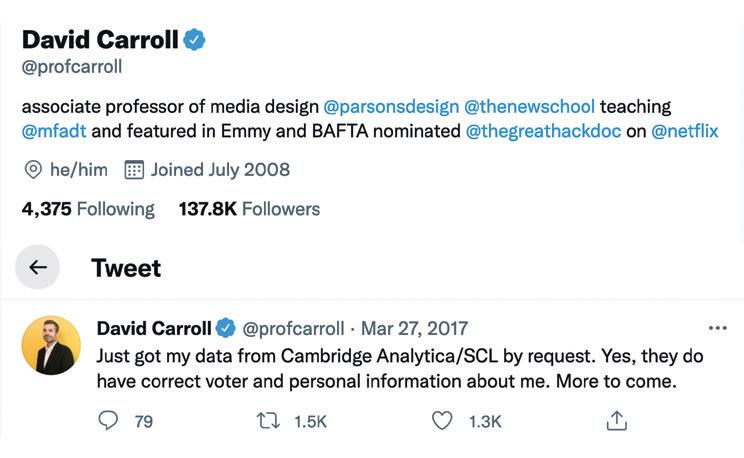
Carroll’s battle to retrieve his personal data has spurred a larger discussion about the regulation of technology platforms and the protection of personal data as a modern-day human rights issue. In digging into the “secret world of voter targeting,” Carroll has brought data rights into
the public discourse, both in state capitals and on city streets. What began as a conversation about technology and regulation has evolved into one on social justice.
Carroll is consistently bringing his students into his work, emphasizing that we must stop pretending that digital technology is still in a nascent, experimental phase. It is time “for it to have a basis of morality and rights and ethics, and it has none. And I think we’re really feeling the brunt of a design field that is rudderless. It’s being instructed by venture capital, not by any sense of a designer having agency

A Critical Moment to Reclaim Data 33
in affecting the world positively. And in most cases, the manipulation is right there on the surface in terms of the harmful aspects of social media.”
Carroll sees The New School as playing an important role in filling this void. Designing ethics into technology begins with faculty and students who understand the contours of this dynamic problem and are willing to maintain standards in leading the way forward.
We will bring solutions not simply by updating our relationship with technology or redrafting user agreements but by “modernizing our understanding of the purpose of government.”
Carroll has been on the frontlines of the debate since 2017, and he holds a unique place in the fight for data rights protection. Having taken Cambridge Analytica to court—and won—he is recognized as a victim of a crime. As an expert in his field, he is also a witness to it.
He has consulted with state governments as they drafted and passed data protection laws, and his fight against Cambridge Analytica has been cited in hearings on Capitol Hill— even though the United States still has not passed a federal law protecting
data rights. Carroll has used the social media platforms he’s seeking to harness to build awareness of data rights.
“Cambridge Analytica to me is the symbol of the dramatic shift in attitude,” he says. “And that cataclysmic change in attitudes is now informing the future. We’re still in a moment of criticality.”
Carroll says that standing up to some of the world’s most powerful governments and companies can be isolating. It has taken a measure of determination, even fearlessness, to carry on the fight.

34 THE NEW SCHOOL

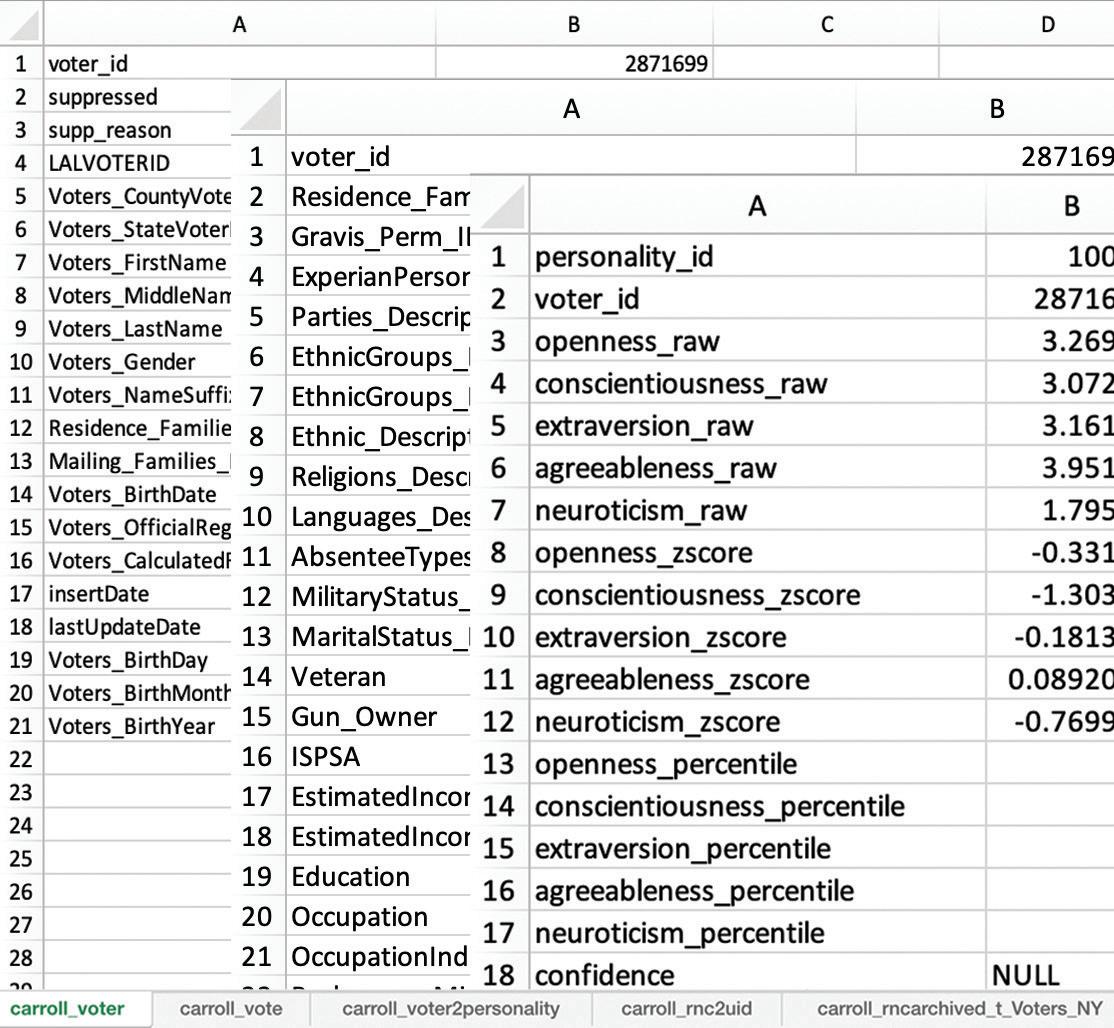
A Critical Moment to Reclaim Data 35
“The problems created by platforms have created a whole new set of subdisciplines for researchers and scholars and designers, activists and lawyers,” Carroll says.
individuals
solve this. We have to find a collective solution to the general problem of surveillance capitalism. And I think that the Design and Technology program at Parsons has already demonstrated a capacity to have some influence inside these organizations.”

36 THE NEW SCHOOL
“It can’t be on
to
Transforming Higher Education with the New Voices of Activism

In fall 2017, The New School began to once again reshape itself with the introduction of the university’s inaugural activist-in-residence. Shanelle Matthews joined The New School for Social Research after serving as the director of communications of the Black Lives Matter Global Network. Her purpose at the university was to connect the practicebased social justice work bubbling up in communities around the world with the rigorous research being done in academia.
Like anyone schooled in social activism, Matthews moved quickly. She taught undergraduate classes, spearheaded workshops, and developed strategic partnerships with social leaders around New York that introduced students to practices designed to help them engage in organizing and activism. Activism, it became clear, is a unique kind of in-the-field research that has a rightful place in higher education.
37
“You can’t have theory and practice together unless you have people who are very well versed in theory—with what we know in humanities, the arts, and social sciences—as well as people who are practitioners in the world,” says Deva Woodly, an associate professor of politics at The New School.

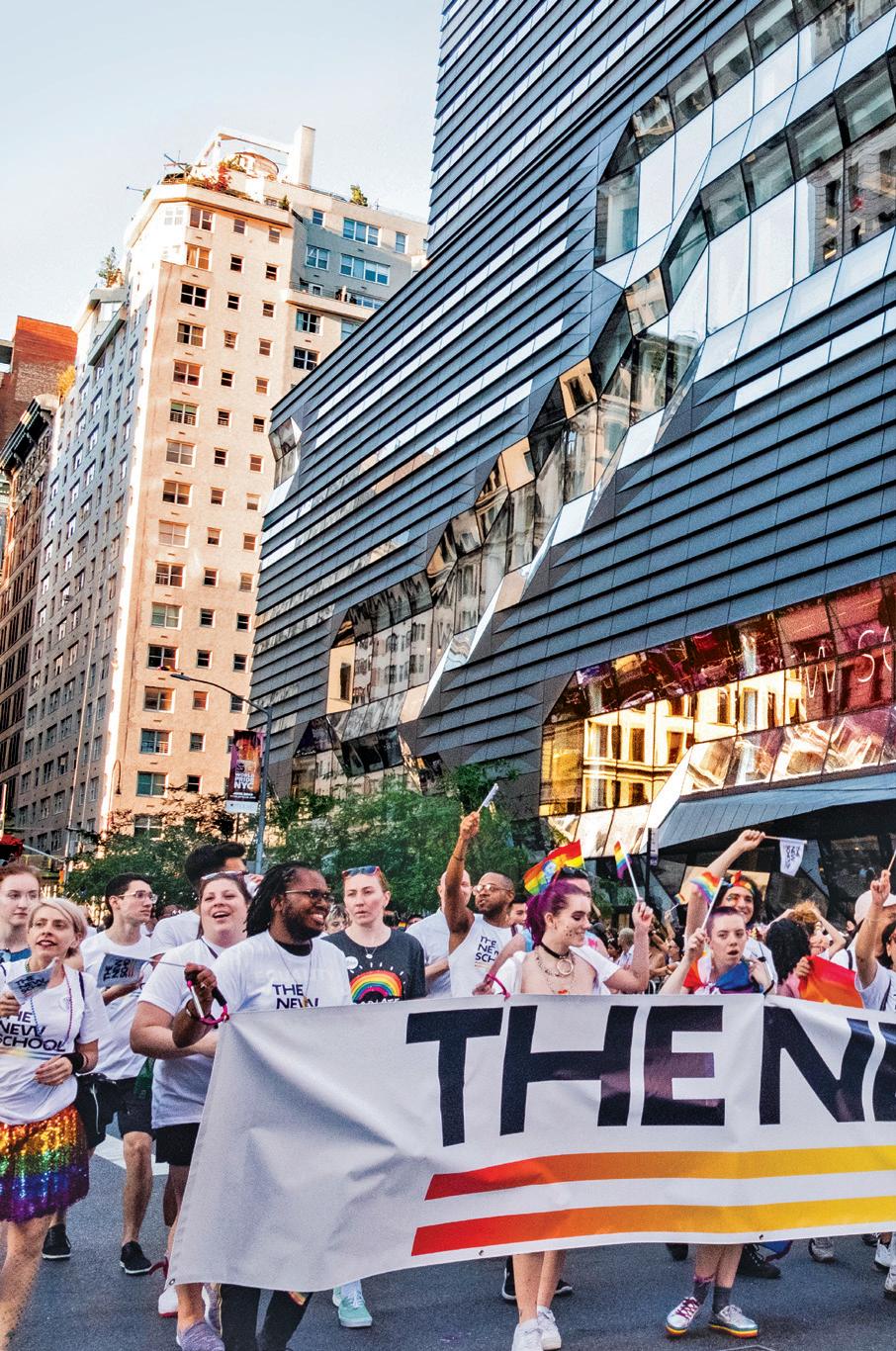
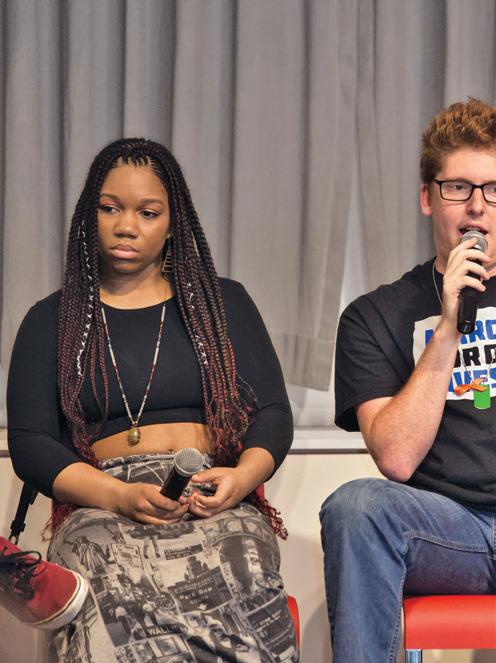

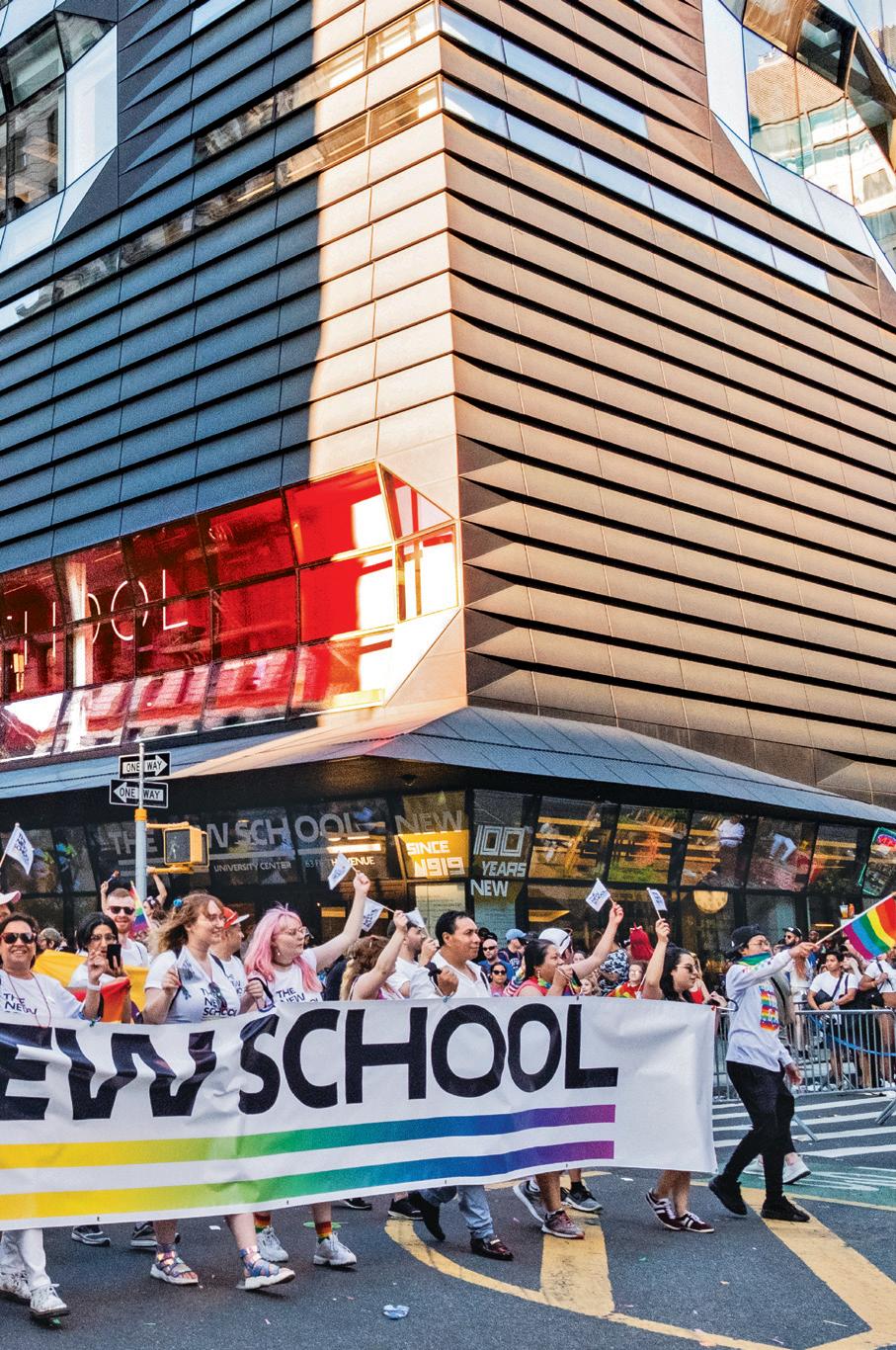
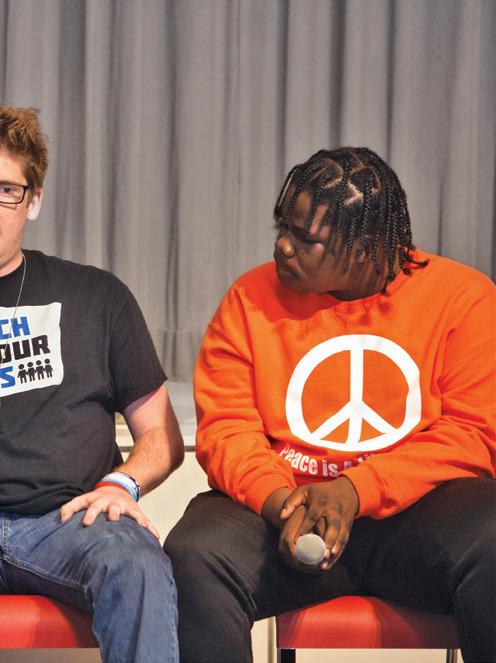
The envisioning of a new kind of academy that began with Matthews has continued at The New School. In 2021, The New School received a pair of grants from the Andrew W. Mellon Foundation worth a combined $5.5 million. The funding will create a pathway into academia for faculty of color and those who study structural inequality. In addition to hiring eight new postdoctoral faculty members, The New School will bring in community fellows like Matthews who
are practitioners in the world to introduce students to a new type of scholarship.

“They are non-academics, activists, and organizers who work at the intersection of structural inequalities using the lens of race as the main analytic,” says Woodly, who played a pivotal role in shaping this program and is an expert in the study of social movements. She recently published Reckoning: Black Lives Matter and the Democratic Necessity of Social Movements (Oxford).
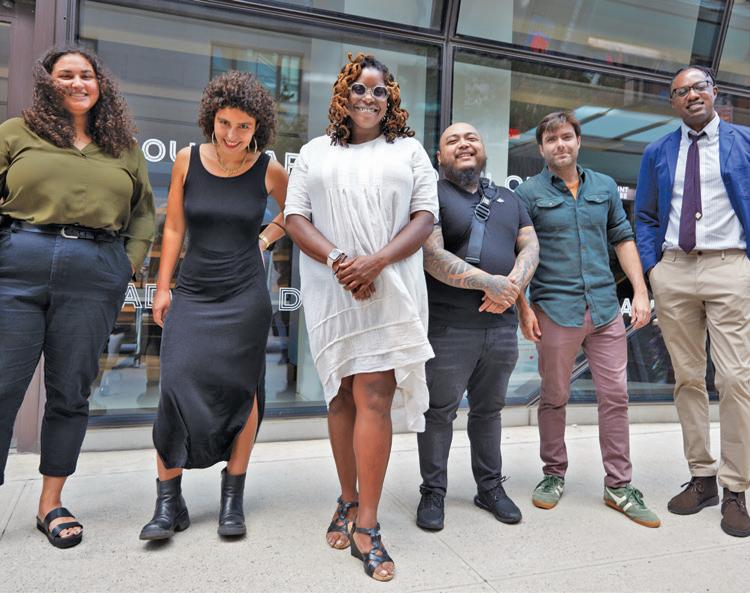
40 THE NEW SCHOOL
The convening of thinkers and practitioners with such rich experience and expertise, Woodly says, will have a transformative effect by creating an innovative intellectual community at The New School. When theorists and researchers interact with practitioners in the field, sparks fly and new ideas explode into being.
“Every time you introduce new knowledges,” Woodly says, “there are unintended consequences and touchpoints for other people.”

Transforming Higher Education with the New Voices of Activism 41
“This is not about having a silo in which people study structural inequality using the lens of race,” Woodly continues. “This is a structuring force in our lives, and it is important for people who purport to be trying to understand the world to really be able to understand and render the world as it is. And that means to be able, whatever you’re studying, to take into account race and its impact.”
There is a common sense to this program, Woodly says, and she envisions it creating a whole new educational ecosystem.

42 THE NEW SCHOOL
“But in order to build a bridge from here to there, there is a certain amount of risk. And you have to be able and willing to take that risk on. And you have to be able to do so, I think, with the heart of a happy warrior.”
Called Upon to Lead in a Complex World: Three Partnerships That Make an Impact
The problems facing people and the planet today have never been more complex. They are worldwide in scale. They require the coming together of multiple, often competing interests. They demand solutions of unprecedented scope.
The New School is often called upon—by governments, institutions, and the world’s largest companies—for its ability to grapple with these complex issues, such as migration, the ethical advancement of technology, and climate change.

The Zolberg Institute on Migration and Mobility aims to cut through partisan talking points to create scholarship that frames the discussion in new ways and changes the lives of people in the world through social action and policy engagement.
The institute has advised New York City and the U.S. government and has worked to assess, map, and project climate-related migration in Latin America, the Caribbean, and sub-Saharan Africa. The institute’s focus on mobility provides students with an advanced perspective from which to analyze a complicated issue.
43


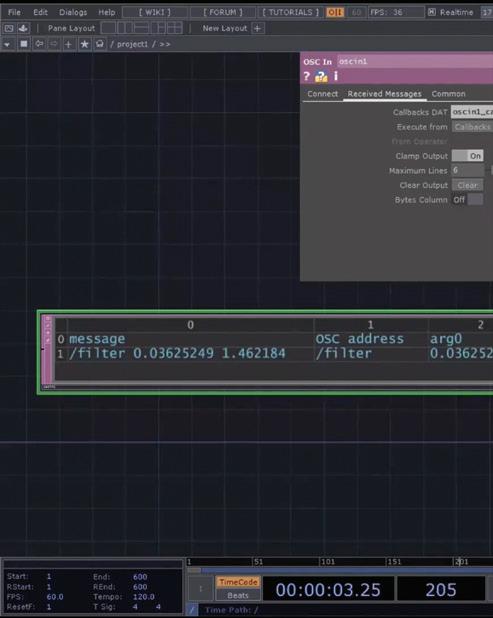

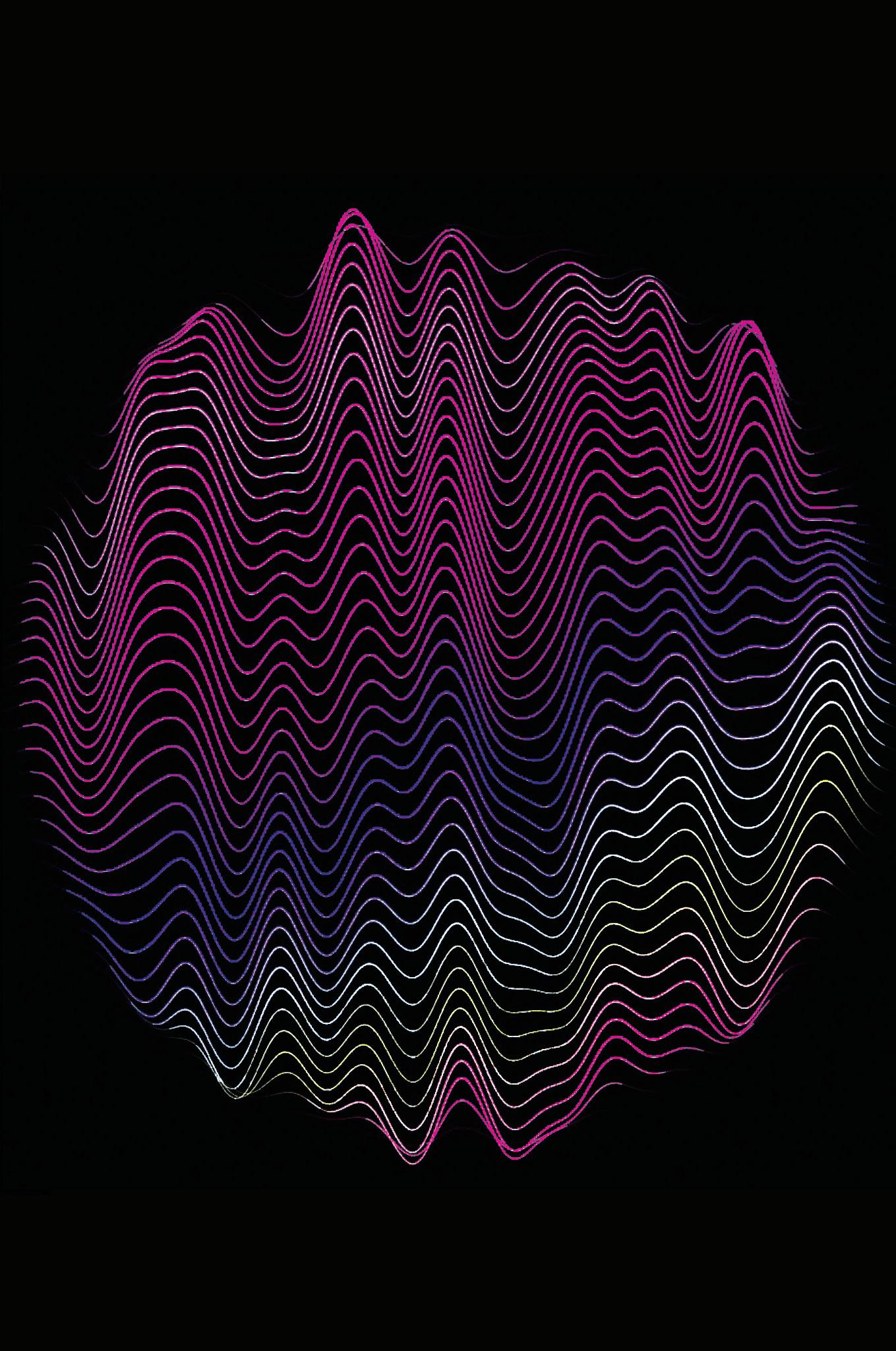
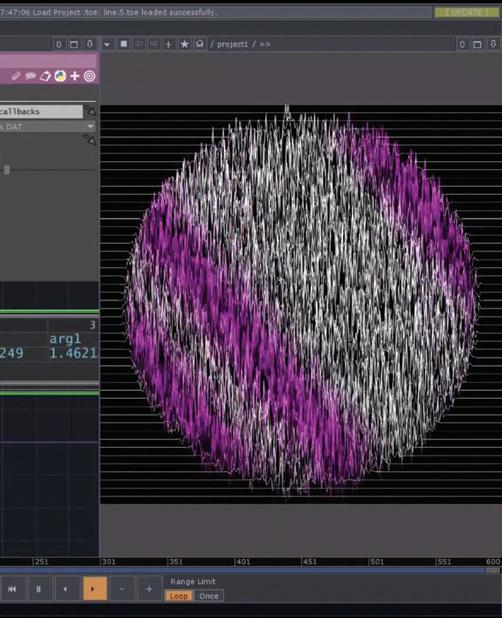
“The New School is unique in terms of being mission driven in the leading immigration city in the world,” says T. Alexander Aleinikoff, who served as co-chair of President Barack Obama’s Immigration Task Force and as United Nations Deputy High Commissioner for Refugees before taking over the Zolberg Institute. “We also have a critical perspective on the world. That combination means we are addressing the most significant problems facing this country in a way that is based on the critical tradition, but in a forwardleaning, progressive-policy way that cares about social justice.”
That commitment to social justice progressed into a new digital realm in 2020 through an innovative partnership with the IBM Global University Programs and the IBM Skills Academy program. IBM chose to work with The New School as a means of advancing this powerful technology while merging it with the university’s social justice efforts.
As New School students and researchers gain early access to IBM’s revolutionary technology
and explore applications of quantum computing in art, design, education, and business, they help weave social justice into the fabric of quantum technology. Founded by Dr. Lin Zhou and associate professor Sven Travis, The New School’s quantum computing initiative has received a FutureEdge 50 Award, which recognizes the most advanced trials and applications of emerging technologies in business.

46 THE NEW SCHOOL
IBM recognized what The New School could uniquely offer to quantum computing. Technology can truly progress only with ethics at its core.
Looking at collaborations through the lens of our values is key to every partnership, but The New School understands that the definition of a problem and the pathways to a solution change depending on the angle from which it is viewed. For instance, the warming of the planet isn’t only an environmental crisis; it is a healthcare crisis, an economic crisis, and, critically, a matter of social justice and equity.

Called Upon to Lead in a Complex World 47
Zhou, senior vice president and chief information officer of The New School, says that when he approached IBM about this partnership, The New School’s background in social justice, not STEM, was its strength.

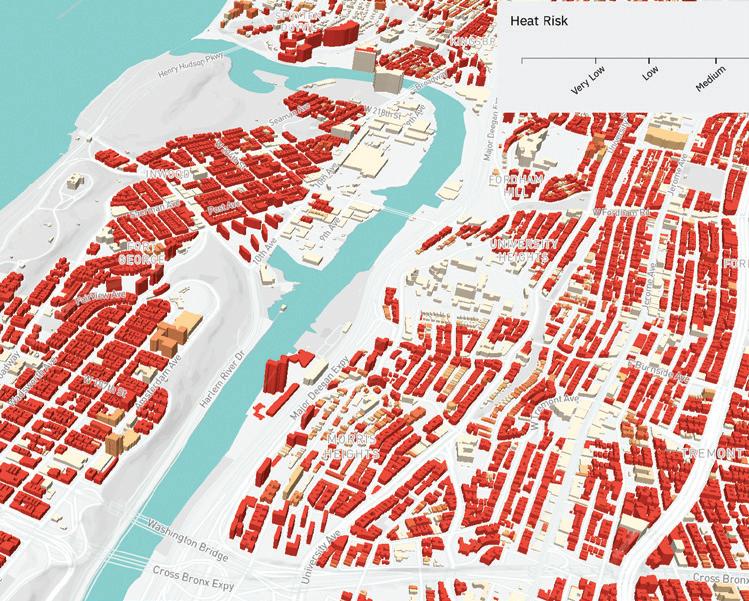
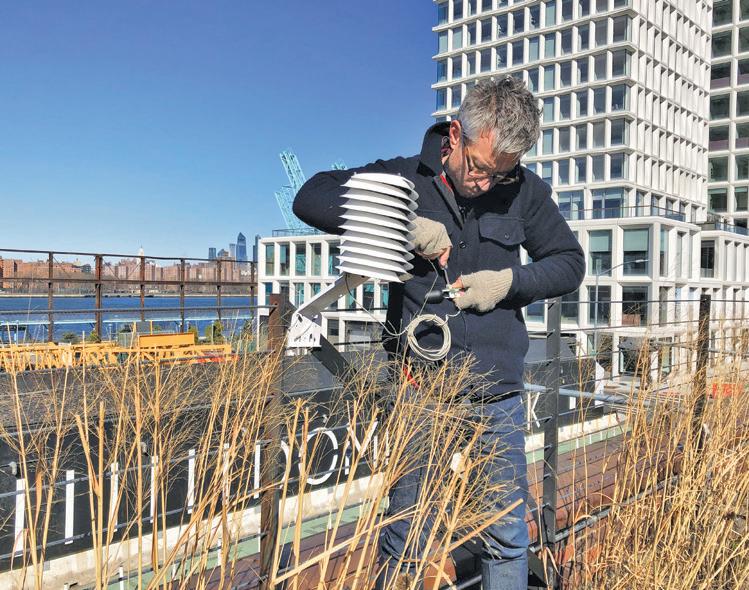
48 THE NEW SCHOOL
“Even minor floods now in someone’s basement, out in Jamaica Bay, New York, are causing moisture buildup, which causes mold problems, which causes health problems, which causes people to have to spend more money on healthcare—and then decreases their ability to adapt in other ways. This is the problem that cities have to face,” says Timon McPhearson, an associate professor of urban ecology at The New School and the director of the university’s Urban Systems Lab (USL). “That’s why we focus on cities. It’s the toughest challenge, but it’s also the most exciting space, because the seats of innovation are in the urban places.”
The USL sees cities as central to both the problem and its resolution and has developed its own approach to combating climate change that combines cutting-edge data analysis and artificial intelligence for naturebased solutions.
In the USL’s work, the voices of data visualization students from Parsons can be heard alongside those of students and scholars with expertise in the social sciences from The New School for Social Research and the Milano School of Policy, Management, and Environment.
As the USL has assumed worldwide leadership in the conversation around climate change, it has attracted partners who are drawn not just to its advanced insights and solutions but to its novel, nuanced approach to the work.

Called Upon to Lead in a Complex World 49
Since 2018, the USL has worked with the City of New York to map out a climate-resilient future for the city. This plan began taking shape in 2021 with the release of the New York City Stormwater Resiliency Plan, a multidimensional roadmap for the city—the first of its kind in the United States—that turns science into practice in combating rising water levels.
“We convened workshops with 60 city agency folks, all in the same room,” McPhearson says. His team then challenged these agencies to work together to find answers to some difficult questions: “What does an adaptive New York look like? What does a more equitable New York look like? And how do we get from here to there in a way that

50 THE NEW SCHOOL
involves

As McPhearson, his team, and his students have deepened their partnership with the city, they’ve also expanded beyond the borders of New York. They are working on similar plans centered on climate resiliency with other North American cities, as well as Helsinki and Stockholm.
In 2019, the lab received $2 million in funding from the National Science Foundation to help develop naturebased solutions for climate change adaptation through a global network of climate change leaders.
Called Upon to Lead in a Complex World 51
the Department of Transportation, the Department of Environmental Protection, city planning, and the Department of Health—all of the big players that are going to have to be part of the solution?”
At the heart of any partnership with The New School is dynamic problem solving, an interdisciplinary approach, and a nuanced understanding of the world’s greatest challenges. No matter the problem, The New School is always ready and willing to cut an uncharted path toward a solution.

52 THE NEW SCHOOL
Redesigning an Industry with New Priorities
“Today when creativity, commerce, and the consciousness of what you’re doing don’t tie in together, you simply can’t be successful,” says Keanan Duffty, founder of Parsons’ Fashion Management master’s program.
An iconoclastic program, it is the only one that teaches the business of fashion within the walls of a preeminent design school and a university known for its focus on social justice. Its goal is to transform the world of fashion not just on the runway but through the systems that frame the entire industry.

“I learned from the school of hard knocks, having some successes and a lot of failures, a lot of mistakes. So when we created Parsons’ Fashion Management program, our goal was to help professionals understand certain aspects of the fashion industry and how it can be an agent for
change. We wanted to help entrepreneurs move their business to the next level, but in a very conscious way.”
Parsons’ goal is to guide future leaders to think about the viewpoints that fashion must address to thrive in a way that moves the industry and the world forward.
Duffty says, “Fashion has still failed to address so many issues. This program begins to address them. There is the actual nittygritty of producing products: In the past, the industry has sought to exploit different regions in order to get a price point and then move on to a different region.
53

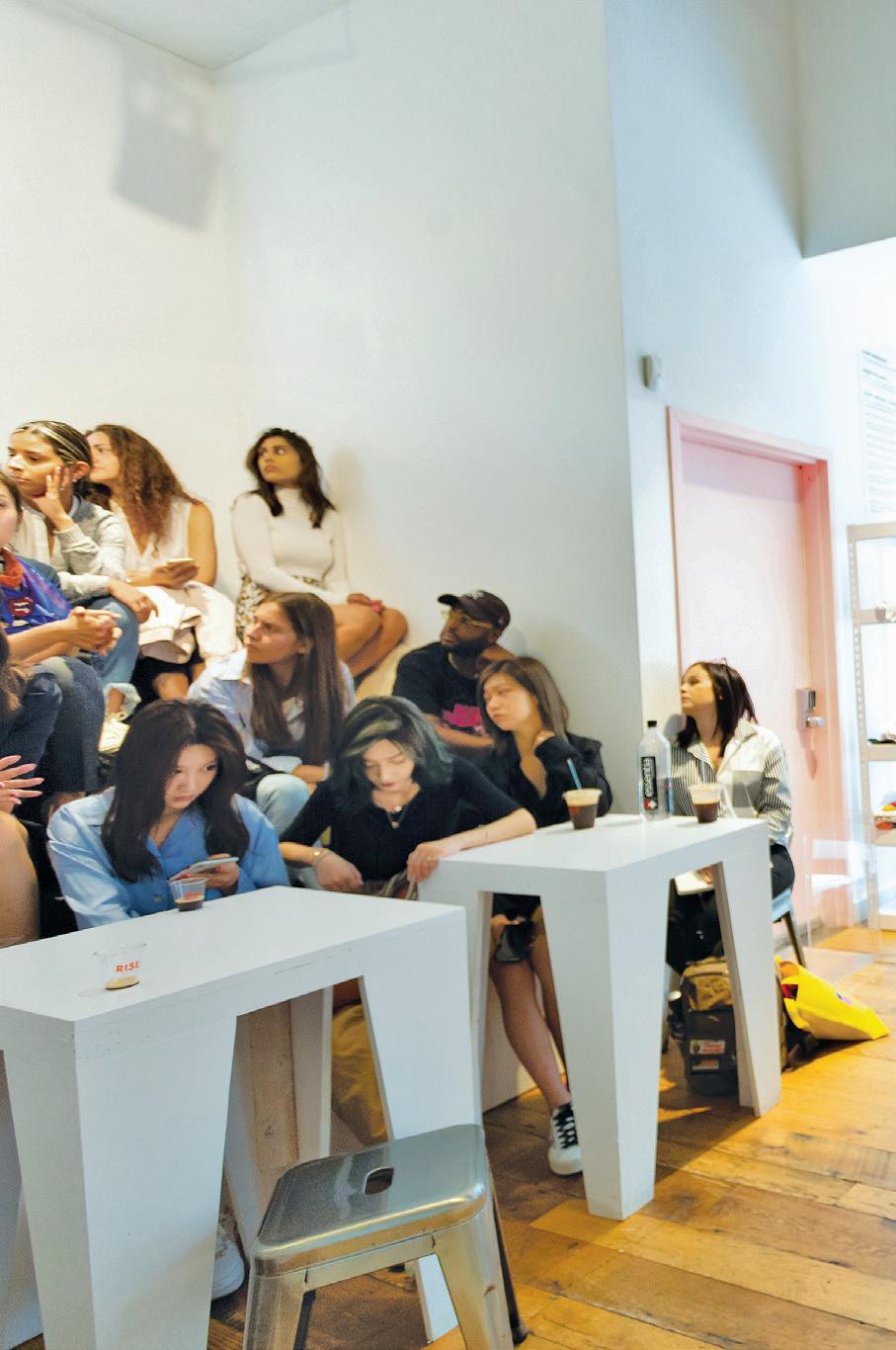
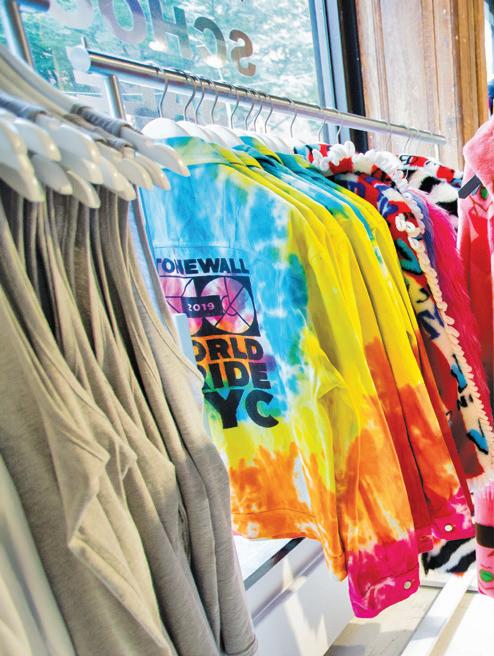

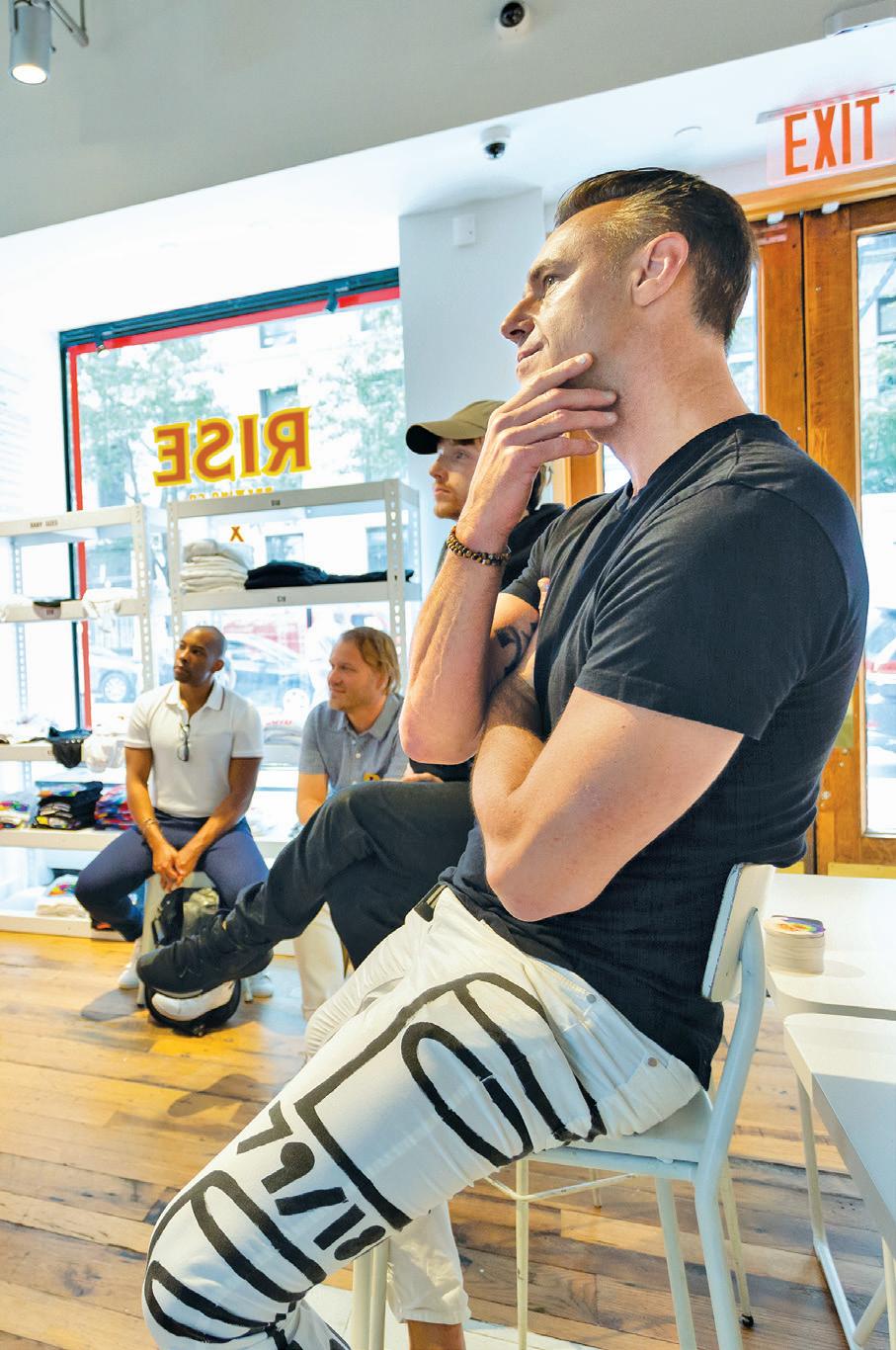
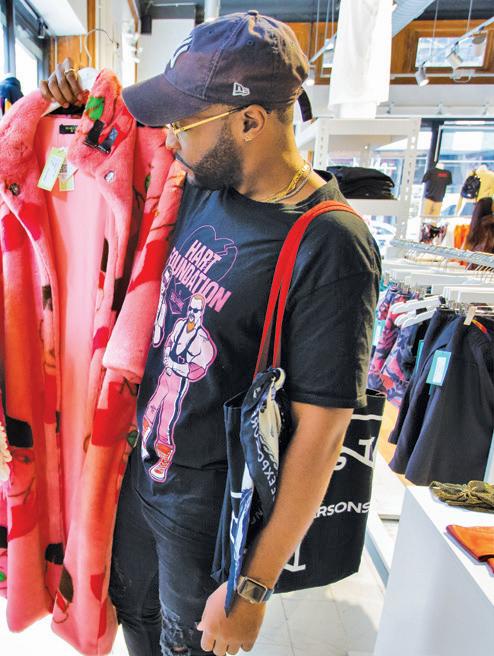
“The industry is out of regions. It’s time to look at production in a way that isn’t exploitative. And that means changing the consumer’s needs and the way fashion is marketed.
“Fashion is not just about coming up with a great idea for a beautiful dress. It’s about the sourcing, the production, the fabric. It’s only if you can actually come to grips with the other aspects of it that you’ll have a greater impact.”

56 THE NEW SCHOOL
“We don’t have a course that is about sustainability; we’re teaching students about sustainability all year. We don’t have a course about inclusivity and diversity; we address that in every course.

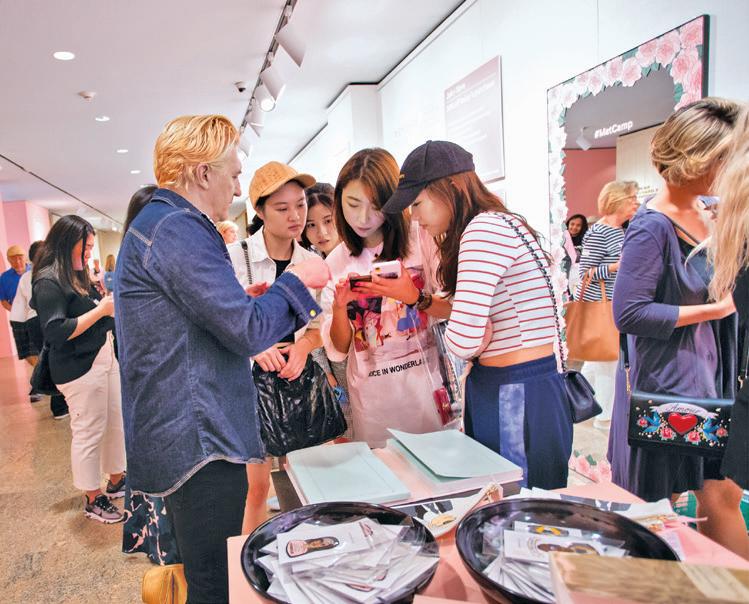
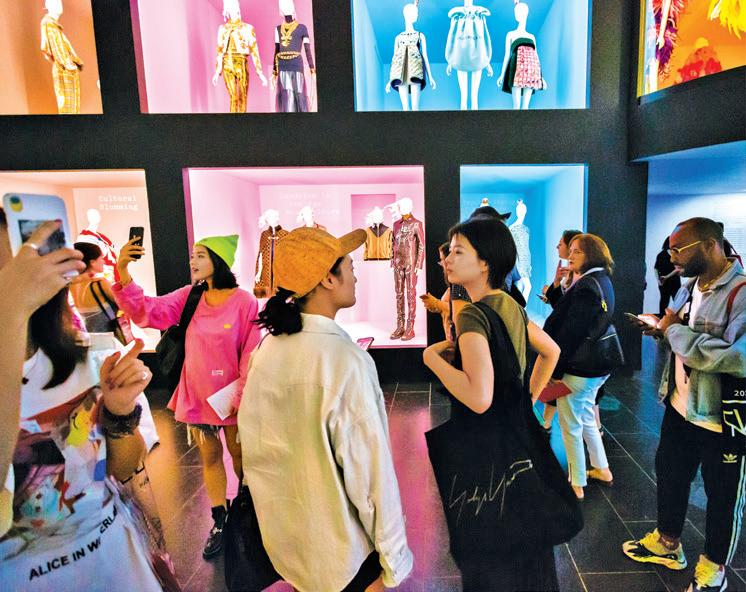
Redesigning an Industry with New Priorities 57
Students in the program find their understanding of the industry transformed in unexpected ways. Before graduating from the program in 2020, Prachi Gor was a designer for a label based in India. She came to The New School looking to merge her creativity with entrepreneurship, but ended up diving into issues of health, labor, and human rights along fashion’s global supply chain.
The Joseph and Gail Gromek Institute for Fashion Business is set to be the next leader in this effort to transform the industry. Founded with an $8.5 million
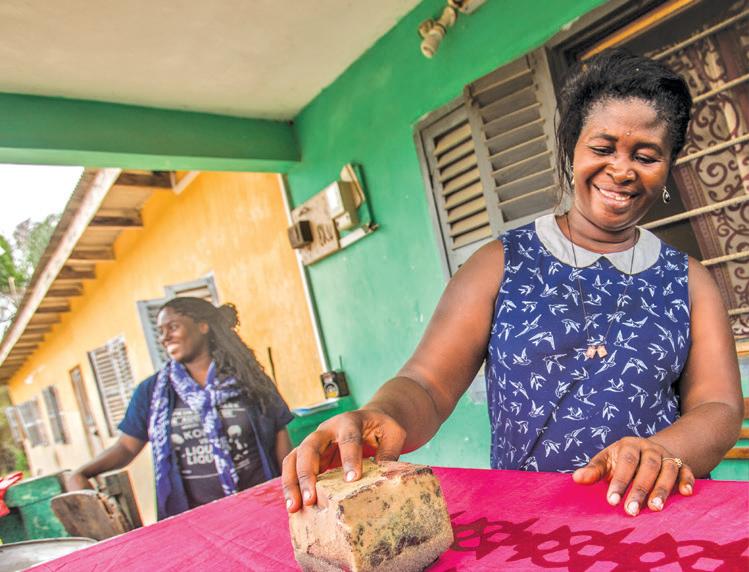

58 THE NEW SCHOOL
“I came here with a plan for my career in mind,” Gor says, “but I walked out with more than a plan. I walked out with a philosophy.”
gift from industry icon Joe Gromek, it is in the first stages of development. The institute’s inaugural director, Abrima Erwiah, envisions the institute as “a hub of information, research, and innovative thinking. Sustainability, social justice, circularity, regeneration, design, fashion, business, legal—all of it will come together in this one space where new ideas can truly flourish.”
Erwiah joins The New School following a successful career in the luxury market. Several years ago, along with actress Rosario Dawson, she founded Studio One Eighty Nine, a social enterprise that promotes and curates African and African-inspired content through manufacturing, distribution, and an artisan-produced collection. Erwiah knows firsthand the many hats one needs to wear in building a brand. “You have to read contracts. You have to understand tech. You have to understand your impact on the planet. You have to be able to sit at a UN conference. You have to do all this and be creative at the same time. How do you possibly prepare students for that?”
The Gromek Institute will work to answer that.
Says Erwiah, “The pursuit of excellence is something I learned from working at luxury brands, but I believe you can translate that to everything, regardless of price. At Bottega Veneta, there was a set of values that permeated the entire culture of the company. There’s a level of humanity at every point. We are going back to this sense of craftsmanship and care. And because of the Internet and its transparency, people will hold you accountable.”

Redesigning an Industry with New Priorities 59
Fearlessly marrying creativity, commerce, and consciousness is critical in fashion, but The New School believes this to be true of all industries. Erwiah is determined that the Gromek Institute will serve as a brilliant example of how this coming together can be achieved.

60 THE NEW SCHOOL
Putting the Arts in the Hands of the Artist
In a one-room venue on the corner of East Second Street and Avenue C in NYC, a temple to music was erected. In 2005, when John Zorn established The Stone, he was looking for a home for the revolutionary kind of music his community of improvisers had been creating since the 1970s.
artists themselves.
At The Stone, Zorn was able to present artists like Mike Patton, Lou Reed, Laurie Anderson, Fred Frith, Ryuichi Sakamoto, Bill Frisell, and Jen Shyu for more than 13 years. In 2018, he knew it was time for a change.
He began a dialogue with Richard Kessler, a longtime friend and the executive dean of The New School’s College of Performing Arts. Zorn had long resisted the idea of joining the ranks of academe. But Kessler saw bringing The Stone to The New School as an opportunity for the venue and a way to advance the college’s tradition of working with experimental artists, such as John Cage and Henry Cowell. With a one-page contract and a promise to uphold the independent ethic of The Stone, Zorn’s temple found a new home. None of the essential rules were changed. The spirit of The Stone that Zorn created lives on.

61
It was an artistcentric place where musicians were given the freedom to play what they wanted. The whole cover fee went directly to the

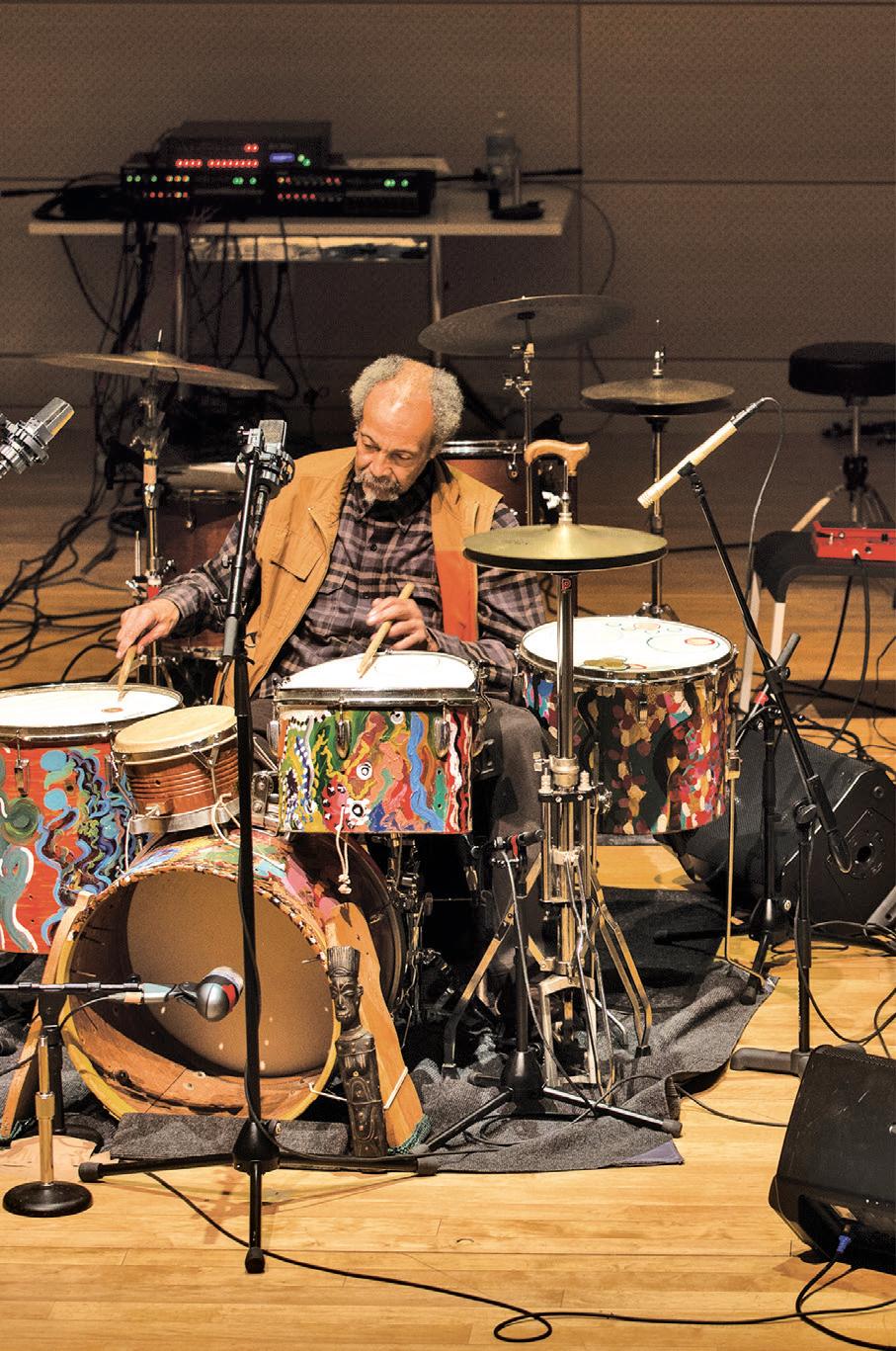
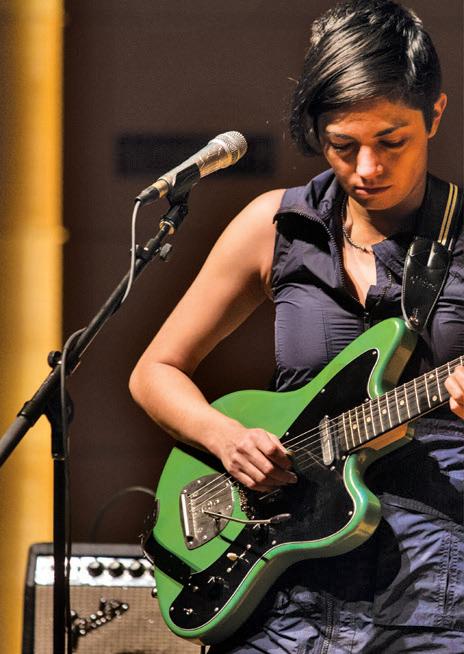

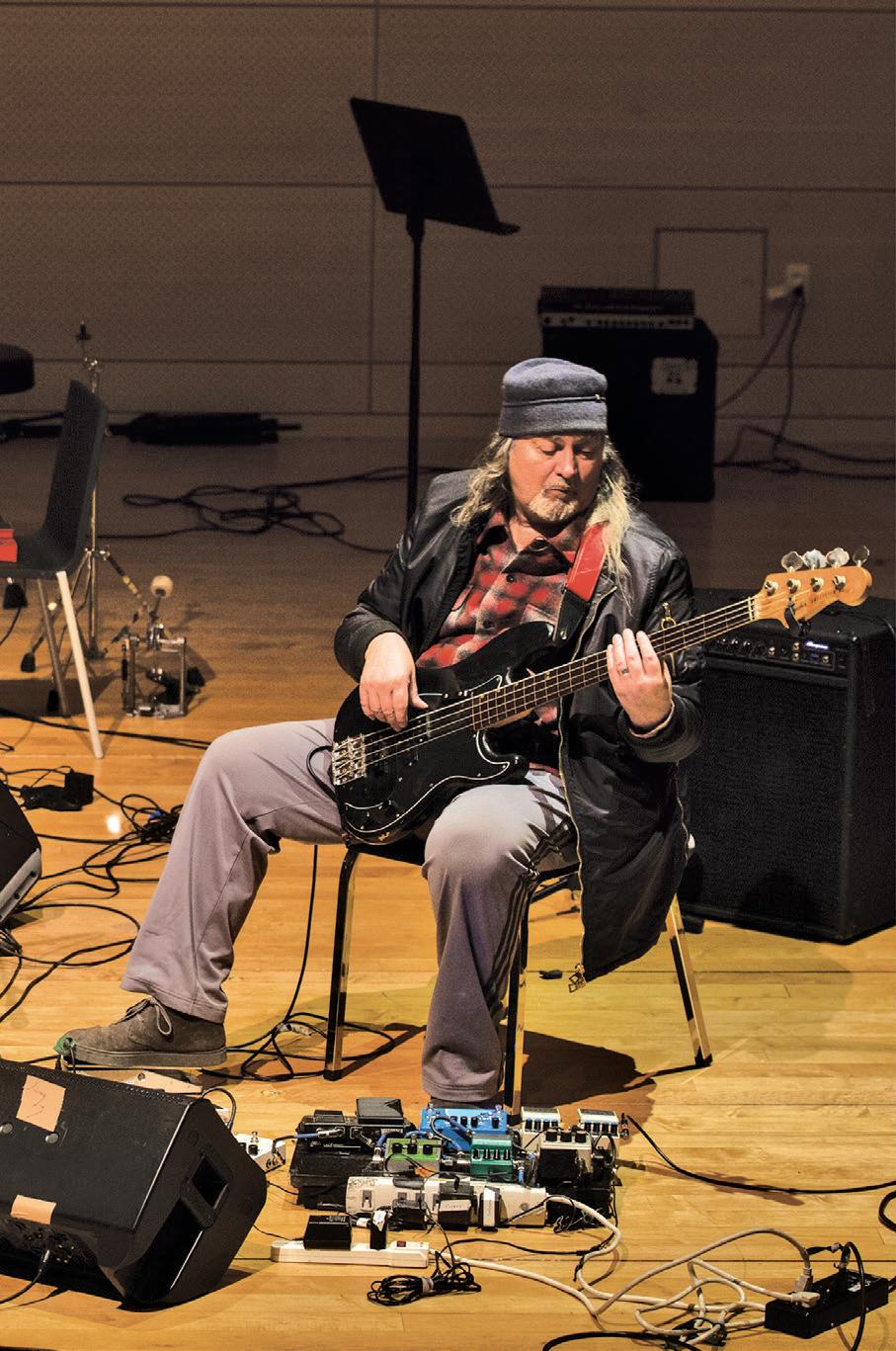
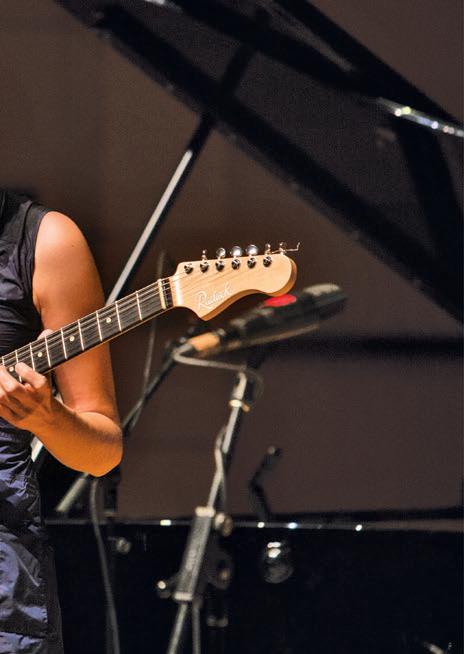
Housed in the Glass Box at the New School, on West 13th Street in Greenwich Village, The Stone is now visible from the street and draws in the musical cognoscenti, locals in the neighborhood, and tourists from around the world. It is a place for artists who defy conventional categorization to collaborate and play freely with New School students, who themselves
represent a new wave of innovative musical talent.
Zorn has always embraced a wide swath of artists cutting across style and genre as well as race, gender, and stature, from up-and-coming artists to boldface names. Zorn curates each season, presenting residencies of one to four weeks in addition to single concerts. The artists-in-residence

64 THE NEW SCHOOL
“In this political, economic, and social climate, it’s time for artists to step up and make a statement. My response is to create work more passionately and more prolifically than ever before. And maybe that needs to involve a more visible space,” Zorn says.
often hold workshops and master classes for students at the College of Performing Arts.
Kessler sees The Stone as part of a broader effort to upend the way the performing arts are taught. The dean’s ultimate goal is to make The New School a home for the avant-garde and a place to instill the spirit of true artistic entrepreneurship in his students in a way no other institution can.

Putting the Arts in the Hands of the Artist 65
Kessler says,
“We see The Stone as a model for activism and advocacy. The students are able to see a venue that gives the artist total freedom, where all the money goes to the artists, where they get paid immediately and they’re treated with absolute respect.”
Together with Zorn, Kessler has ensured that a generation of students can learn directly from these experimental talents, making the College of Performing Arts a place where the greats and the next generation of icons play together and carry forward a tradition of bold exploration. Only the fearless need apply.

66 THE NEW SCHOOL

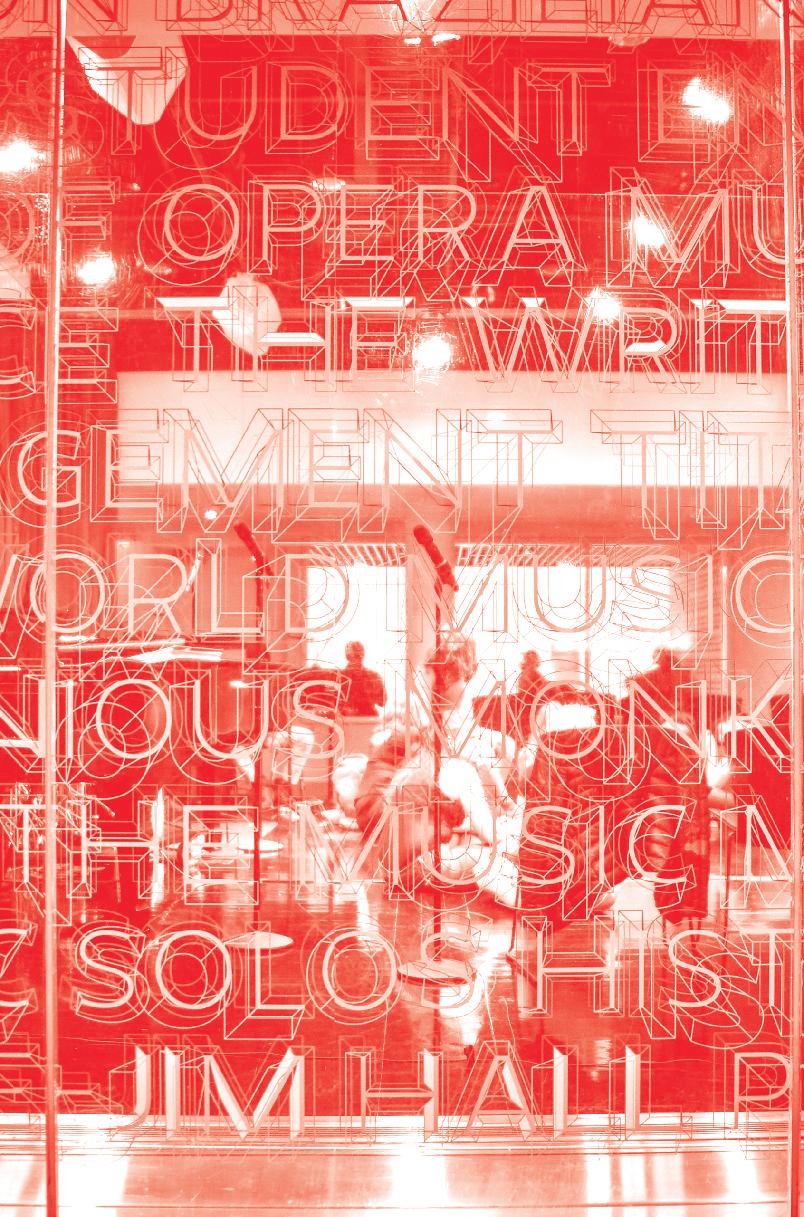

67


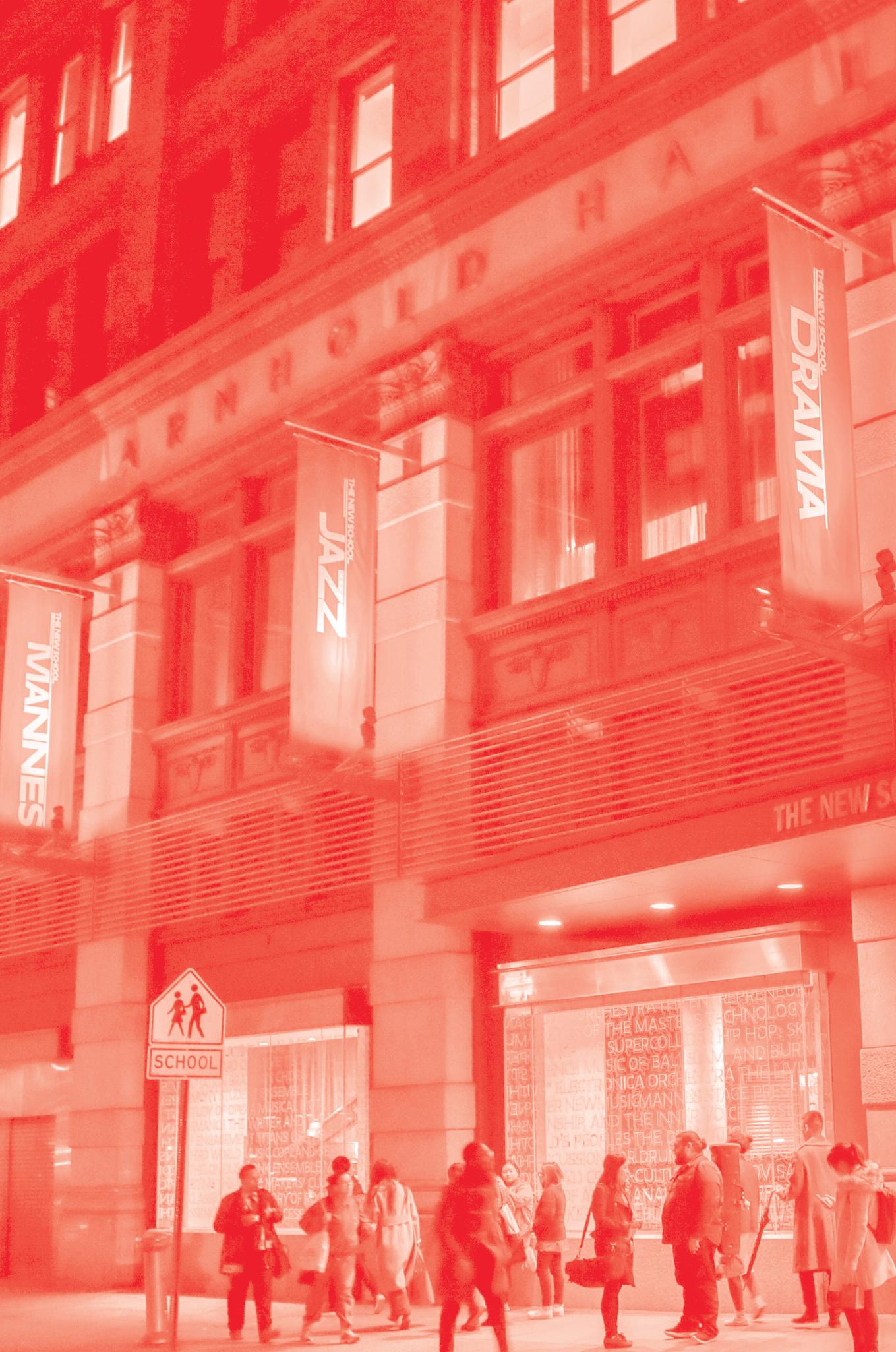

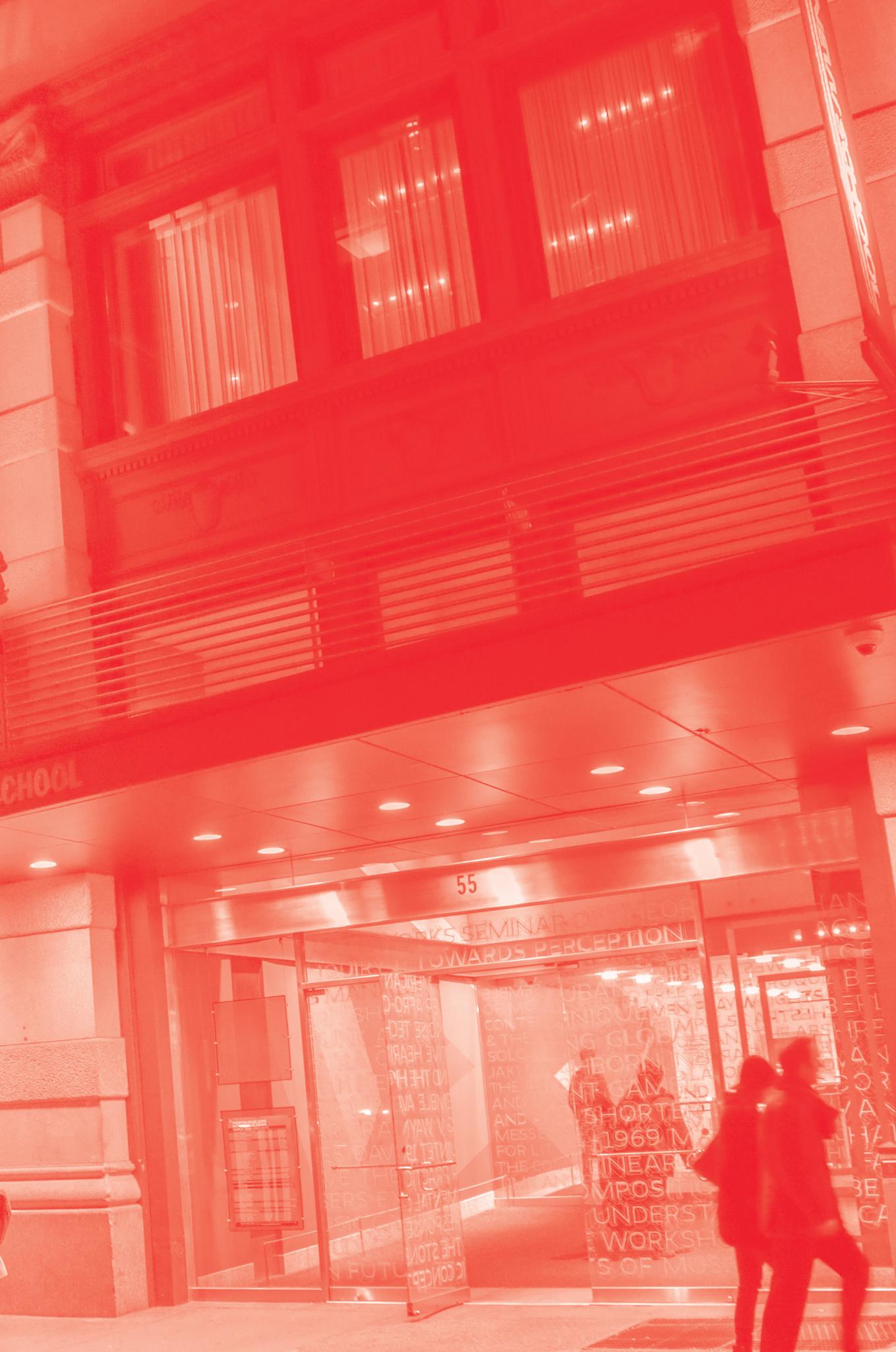
“I can’t understand why people are frightened of new ideas. I’m frightened of the old ones.”
John Cage, former faculty, The New School
A New Story for the World

John Cage did not simply create a new genre of music; he altered the future of music.
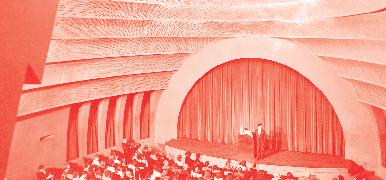
Marc Jacobs didn’t just create a new kind of fashion; he transformed the way fashion was inspired.
Martha Graham didn’t just create a new kind of dance; she forever changed the trajectory of dance.
Today the changemakers—faculty and scholars— whose stories appear on these pages carry forward this legacy as they break molds and rewrite the course of their disciplines. It is this passion for unearthing the fearless next step in designing a better world that has united all New Schoolers. This has been true from the institution’s very beginnings, in 1919, when a group of professors left Columbia and conceived of a new education model, forming The New School. When scholars fleeing European fascism came to the United States, dozens passed through our doors and laid the foundations for our degree programs.

70 THE NEW SCHOOL
This is the place where the new is born. Not just new ideas, but new ways of thinking and seeing the world. Not just new products, but new paradigms. Not just new ways to work, but whole new worlds. Every day, a new story for the world is emerging here.
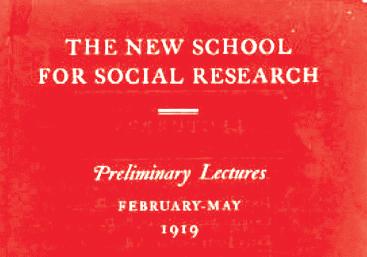
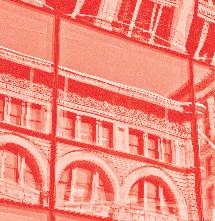
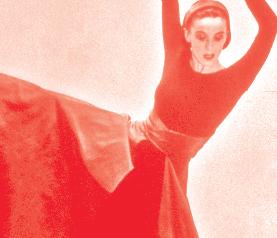
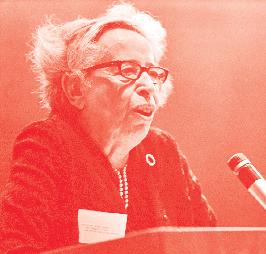

71 A place for fearless progress
United by the desire to solve the most critical problems of our time in new ways

Teaching the power of creativity to do good in the world
CROSS-POLLINATION OF IDEAS ACROSS ALL OF OUR SCHOOLS
A university engaged with the issues and connected to the world
Prioritizing humanity and culture in designing systems and environments to improve the human condition
72 THE NEW SCHOOL
7 schools — one university 7 schools one university
An approach that draws on design thinking and the liberal, creative, and performing arts
collaborative, project-based learning at the center of the educational experience
Our home is in NYC. Our connection is to the world.
THE ROAD TO FEARLESS PROGRESS

73 A place for fearless progress
7 schools — one university 7 schools one university
SOME OF OUR GROUNDBREAKING ALUMNI
SHEILA BRIDGES
Interior designer, TV host
KEVIN KWAN
Author of the Crazy Rich Asians satirical series
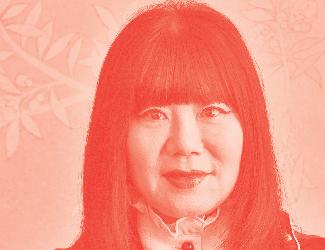
MARC JACOBS
Fashion designer, activist
ROBERT GLASPER
GRAMMY Award–winning pianist, producer
ANA OLIVEIRA
President and CEO, New York Women’s Foundation (NYWF)
RYAN GERMICK
Creator of Google Doodle, digital creative director
LAURA POITRAS
Academy Award– and MacArthur
Fellowship–winning filmmaker, artist
TRACY REESE
Fashion designer, entrepreneur
THOMAS DINAPOLI
New York State comptroller
AI WEIWEI
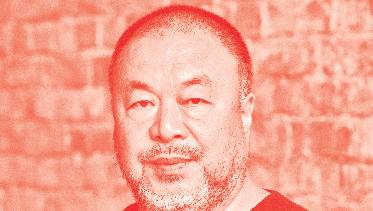
Fine artist
NARCISO RODRIGUEZ
Fashion designer
VALERIE COLEMAN
Flutist, founder of the GRAMMY-nominated Imani Winds ensemble
HARRY BELAFONTE
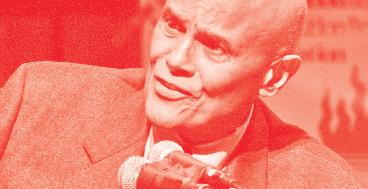
Performer, activist
MAYA MUMMA
Academy Award–winning film editor
NELSON BARBOSA
Former finance minister of Brazil
ANNA SUI
Designer, entrepreneur
STEVEN MEISEL
Photographer
NADINE SIERRA
Soprano
TOM FORD
Designer, filmmaker

ANI DIFRANCO
Singer-songwriter, producer
DR. RUTH WESTHEIMER
Sex therapist, TV and radio host
DONNA KARAN
Fashion designer, entrepreneur, activist
74
SOME TO WATCH
JULIO TORRES
BA Literary Studies ’11
Writer, comedian, actor, co-creator of Los Espookys
WILLEM DE KOCH
MA Arts Management and Entrepreneurship ’19
Trombonist, composer, co-founder of The Westerlies quartet
EMILY ADAMS BODE
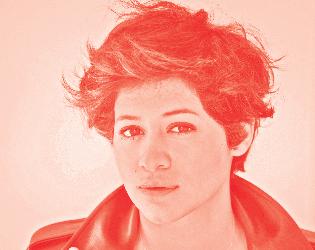
BA Philosophy/BFA Fashion Design ’13
Founder of Bode luxury menswear
ZAKIYA DALILA HARRIS
MFA Creative Writing ’16
Author of The Other Black Girl
VLADISLAV GINZBURG
BS Liberal Arts ’12

CEO of Blockparty
MARIA KAZAKOVA (JAHNKOY)
MFA Fashion Design and Society ’16
Fashion designer, sportswear designer
RAY ACHESON
MA Politics ’14
Member of the steering group of the Nobel Prize-winning International Campaign to Abolish Nuclear Weapons
JILLIAN HERVEY (LION BABE)
BA The Arts ’11
Musician, performer
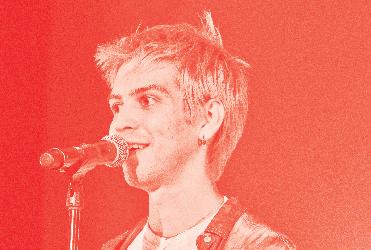
SEEMA SHAH
MS Urban Policy Analysis and Management ’09
Assistant deputy superintendent, Innovation, at NYS Department of Financial Services
NINA CHANEL ABNEY
MFA Fine Arts ’07
Fine artist
LINDA BRICEÑO
BFA Jazz and Contemporary Music ’18; MA Arts Management and Entrepreneurship ’19
Trumpeter, songwriter, producer, singer
ALEX LEVIN AND RYAN RIEGNER
BBA Strategic Design and Management ’11/BFA
Communication Design ’11
Founders of L+R design agency
ELLA EMHOFF
BFA Fine Arts ’21
Knitwear designer, model
HEATHER BOUSHEY
MA Economics ’96; PhD Economics ’98
President and CEO of the Washington Center for Equitable Growth
MYLES LOFTIN
BFA Photography ’20
Photographer
FABIAN RAPHAEL RASTORFER
BFA Design and Technology ’14
Founder of Fabraz game studio
MEREDITH RAMSAY (EZINMA)
MM Instrumental Performance ’14
Violinist, film composer, educator
GEOFFREY MCDONALD
MM Orchestral Conducting ’09
Music director of On Site Opera
REBECCA BAILIN
MA Sociology ’12
Senior advisor for NYS Senator Andrew Gounardes
SEAN BAKER
MFA Transdisciplinary Design ’14
Innovation and systems designer, U.S. government

75 A place for fearless progress
IMAGE APPENDIX: SEVEN STORIES ABOUT THE NEW SCHOOL
CREATING A MORAL ECONOMY
The Institute on Race, Power and Political Economy: https://www. newschool.edu/institute-racepolitical-economy
(page 18) University Professor

Darrick Hamilton, founder and director of the Institute on Race, Power and Political Economy.
(page 19) The Role of Race, Labor Markets, and Education, report by Darrick Hamilton, Ofronama Biu, Christopher Famighetti, Avi Green, Kyle Strickland, and David Wilcox for The New School’s Institute on Race, Power and Political Economy, February 2021.
EPI Analysis of Current Population Survey Outgoing Rotation Group Microdata from the U.S. Census Bureau, Economic Policy Institute, epi.org.
BUILDING A HEALTHIER PLANET
Healthy Materials Lab: https:// healthymaterialslab.org
(pages 22−23) BACKGROUND: Hemp fiber drying at Winona’s Hemp (photo: Jonsara Ruth)
FOREGROUND: HempLime block (photo: Jonsara Ruth).
(page 24) Alison Mears and Jonsara Ruth in conversation with Winona LaDuke about collaboration on two HempLime houses for elders on the White
Earth Reservation in Northern Minnesota (photo: Winona LaDuke).
(page 27) Healthy Materials Lab members and Parsons architecture and design students mixing hemp and lime at an HML workshop led by experts from CoExist (photo: Michelle Gevint, MFA Photography ’14).
(pages 28−29) BACKGROUND: HempLime bricks being made (photo: Michelle Gevint, MFA Photography ’14); FOREGROUND: The Healthy Materials Lab office (photo: Michelle Gevint, MFA Photography ’14).
A CRITICAL MOMENT TO RECLAIM DATA
(page 33) @profcarroll, David Carroll’s Twitter account, where he shares and discusses information regarding data rights, ethics, and technology.
(page 35) Examples of personal data belonging to David Carroll collected by Cambridge Analytica and obtained by British journalists in 2020. Millions of data profiles just like Carroll’s—including psychological profiles of all U.S. voters—were used by the Trump campaign in 2016 to target voters with political messaging despite.
76 THE NEW SCHOOL
TRANSFORMING HIGHER EDUCATION WITH THE NEW VOICES OF ACTIVISM
(pages 38−39) BACKGROUND: WorldPride NYC 2019.
FOREGROUND: Gun Reform in Black & White: Student Activism and #NeverAgain.
(page 40) FROM LEFT TO RIGHT: Sonia Inam, program manager for the Mellon Initiative for Inclusive Faculty Excellence; Romy Opperman, Philosophy postdoctoral fellow; Deva Woodly, faculty director; P.J. Gorre, dissertation fellow; Emmanuel Guerisoli, Mellon Initiative research assistant; Jonathan Square, postdoctoral fellow at Parsons’ School of Art and Design History and Theory, at the Mellon Initiative for Inclusive Faculty Excellence kickoff event.
CALLED UPON TO LEAD IN A COMPLEX WORLD: THREE PARTNERSHIPS THAT MAKE AN IMPACT
Zolberg Institute: https://www. newschool.edu/nssr/centersspecial-programs/zolberginstitute-migration-mobility
Urban Systems Lab: http:// urbansystemslab.com
(pages 44−45) Quantum visualization, developed from

a quantum number generator by Jiyoon Moon, Parsons Design and Technology student.
(page 48) TOP: Timon McPhearson installing a temperature and irradiance sensor to measure the cooling potential of green roofs at a location in Brooklyn.
(page 48) BOTTOM: Urban Systems Lab Data Visualization Platform, heat risk data layer for New York City.
REDESIGNING AN INDUSTRY WITH NEW PRIORITIES
(pages 54−55) BACKGROUND AND FOREGROUND: Field trip to The Phluid Project, Fashion Management Intensive Week.
(page 57) TOP: Keanan Duffty with students. BOTTOM: Field trip to The Metropolitan Museum of Art, Fashion Management Intensive Week.
(page 58) Abrima Erwiah, left, working with makers in the field (photo: Adam Desiderio for Studio One Eighty Nine).
PUTTING THE ARTS IN THE HANDS OF THE ARTIST
(pages 62−63) BACKGROUND AND FOREGROUND: StoneFest at The New School, John L. Tishman Auditorium in the University Center, 2017.
77 A place for fearless progress
The audio version of this book can be found at newschool.edu/fearless.
This book is printed on 100 percent recycled paper with UV inks that conserve energy and materials and do not release VOCs into the atmosphere, reflecting the university’s embrace of environmental responsibility.
Published 2021 by The New School.
The New School is an Affirmative Action/Equal Opportunity Institution.
80 THE NEW SCHOOL


















































































